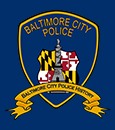1960 - 1980
![]()
1960 - 1980

Photo Courtesy Lt. William Bowen
Officer William Bowen
1960
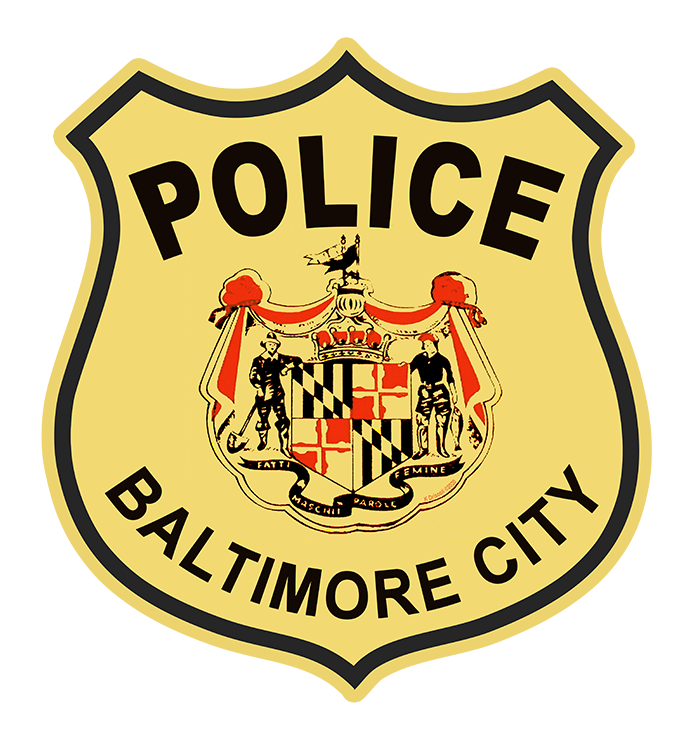
1967-1973
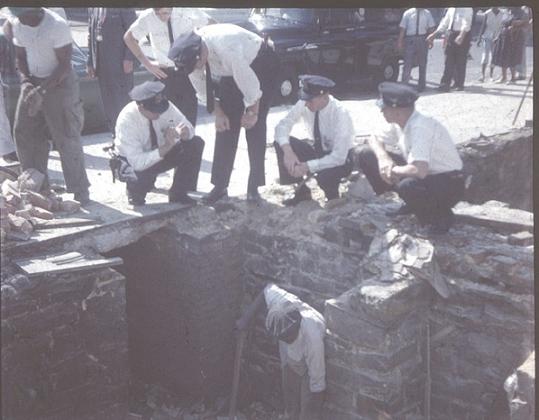
OFFICERS CONDUCTING AN INVESTIGATION 1960s

1962
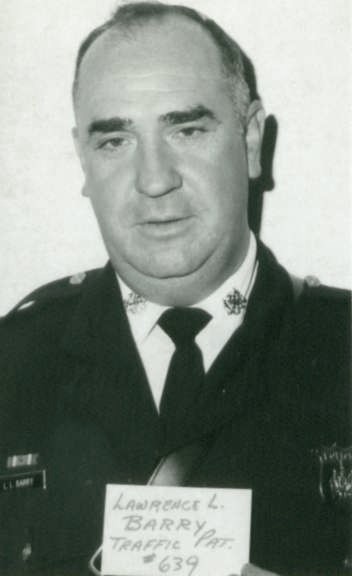 |
| Photo courtesy Det. Charlie Smoot |
Officer Lawrence Barry seen here in a departmental ID card shot was in the Baltimore Park Police and when that agency merged with the Baltimore City Police around 1961 he joined the Baltimore Police Department and retired in the 1970's. Officer Lawrence Barry was an uncle of Detective Charlie Smoot Below Officer Lawrence Barry is seen wearing a vintage uniform complete with the old "bobby" type hats, 3 rd. issued badge.
 |
| COURTESY MAJOR ROBERT DiSTEFANO |
Officer Robert DiStefano as the young grunt in 1962
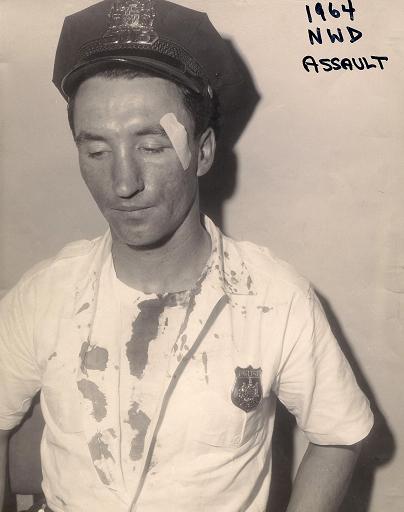 |
| Photo courtesy Officer William Hough |
Officer William Hough is seen here with cut on his face and a bloody uniform shirt after being the victim of an assult on a police officer.
 Sgt Charlie Barclay
Sgt Charlie Barclay
circa 1960
![]()
AS 600-PAGE SURVEY RAPS CITY POLICE
RICHARD H LEVINE
The Sun (1837-1987); Jan 10, 1966;
pg. A1
Organized crime, place our terms of widespread
Police recruit standards down low…… page A9
By Richard Levine
The Baltimore Police Department has been closely examined and found to be seriously inadequate by the nation’s leading consulting firm specializing in police administration.
The 600 page report issued last night focuses severe criticism at the quality of leadership and management in the police department.
It points up many areas of critical deficiencies and levels both broad and detailed attacks on almost all aspects of police service, all phases of police administration and all divisions, bureaus, squads and specialized functions.
Reorganization Asked
It recommends an immediate, total reorganization of the department and immediate attention to some essential policing responsibilities that are most severely crippled by bad management practices.
It asserts that despite contrary opinion of the public, Baltimore is saddled with place and organization crimes of major proportions.
The report is the result of a $52,000 March to October study conducted by the field service division of the international Association of Chiefs of police.
Besides the dissection of the department problems, the report contains detailed recommendations for improvements.
Two Principal Concerns
The report bears down particularly hard on the top principal concerns of the Police Department – crime control and traffic control.
It engages in widespread faultfinding in both areas. The consultants recommend that the police department remain a state agency and that the governor retain its statutory power to appoint the Commissioner and his power to remove him from office misconduct for incompetency. Other major recommendations are these:
- The organization of the department according to functions with clear lines of authority and responsibility. Include is the elimination of the rank of inspector and chief inspector.
- The inauguration of an accurate, complete crime records system revision of beat patterns
- A total revision of the beat pattern to equal the workloads of men in patrol.
- The proper development of the planning and research division with a crime analyst unit and expanded use of data processing.
- The creation of a criminal investigation division for expert handling of all felonies and major vice cases from evidence gathering to preparation for trial.
- The implementation of the internal investigation unit – now only on paper – as the commissioners watchdog on the department, responsible for intelligent information on misconduct, corruption, abuse of authority and the activities of organized crime figures.
Urges Formal Procedures
7. The establishment of formal disciplinary procedures and a disciplinary board for the prompt proper handling of charges brought against officers from within the department or civilians.
- A formal system for airing grievances of uniformed and civilian employees of the department with the right to make formal grievances guaranteed by state law.
- Higher education, physical mental and medical standards for applicants to the force.
- A revision of the standard for rating candidates for promotion.
- The restriction of promotion to the top five candidates on a merit rating list.
- A serious police community effort to reduce the high automobile accident injury and fatality rate in the city with a special pedestrian safety program.
- Elimination of the present law which restricts candidates for the position of Commissioner to residents or businessmen in the city.
- A general increase in salaries and benefits including any bays, holidays, overtime pay, insurance benefits and uniform supplies.
- The construction of a new department headquarters building: the immediate elimination of northern district with its patrolling divided between Northwest and Northeastern: the abandonment of the northern district headquarters building as soon as the police Academy can be moved to a newly constructed department headquarters building: the eventual abolishment of the southern district and a abandonment of its headquarters building.
It also calls for a realistic attitude toward problem of vice and crime and a harder attack on these conditions and on the block as a source of “moral blight.”
Two subjects that have drawn much public interest recently are handled by recommendations that the Police Department relieve itself of responsibility for them.
The consultants believe that all towing matters, removal of illegally parked vehicles as well as vehicles and accidents, should be turned over to private contractors.
Sanitary Inspection
And it recommends that the city assume the task of sanitary inspections.
The consultants call for the abolishment of the auto theft squad, the pickpocket, hotel and V. I. P. Squad, the riot squad, the mounted sections horses, and the transfer of their functions elsewhere.
There are thousands of specific suggestions directed toward every subject from the meter maid’s manner to the length of the Espantoon.
Even as it urges an immediate program of reform, the report points out that the consultants while engaged in the study, were met with the kind of obstinate resistance that prevented improvements and progress in the department in the past.
“These recommendations will be of little value unless the administrative climate of the Police Department is changed,” the reporter says.
“Superior officers must accept the fact that the department needs improvement and must recognize their responsibilities and lifting the department from its content with the status quo and traditional concepts, to those of the modern, progressive and efficient department the community deserves.”
First Study in 25 Years
the report points out that this is the first comprehensive survey of the department in 25 years, that the reorganization plan suggest that in the previous report was never adopted and that they did department’s structure is virtually unchanged from that which existed in 1940. The report warns:
“It is to be hoped to that history does not repeat itself: restructuring the Baltimore Police Department is sound in importance only to improving the competence of its management.”
The consultants ordered the following guide to their own approach to the survey: “of this report is critical in nature, because in an effort of this type, the most intensive examinations are naturally made into existing weaknesses.
“Intentions of this criticism is that it be constructive: that it assists in improving the organization, personnel and practices of the Baltimore Police Department so that the people will receive effective police services consistent with democratic ideas.
“It should be remembered that the survey is directed toward all police activity and is not just a narrow search for faults. Thus it is consistent with the standards of objectivity.”
The criticism is of two types: that directed toward practices and policies that are not as effective as they should be, and exposure of major flaws that are so basic as to cripple the department. As late as this fall, the department walked on the implementation of two aspects of report that were considered to be important enough for immediate action.
The police Association consultant said that the recommendations on record management were presented in preliminary form to Commissioner Bernard J Schmidt and his inspector on September 21, 1965.
Final Report Presented
Several meetings were held to discuss the recommendations, the consultant said, and a final report was presented to the department on 20 October to enable the Department to inaugurate new reporting procedures by the start of the calendar year.
“Despite this, to date the department has taken no action whatsoever in preparation for a change in the present reporting procedures.”
“A second matter indicated similar dilatory handling.” Says the report.
On September 29, the report says, the police Commissioner was given to plans prepared by the I. A. C. P. For the establishment of an internal complaint investigation procedure.
These plans were made after conference had taken place with major McKeldin and Gov. Tawes. There were later conferences.
A Capt. was promoted to inspector, the report says, “reportedly to command the proposed new unit. The plans, however, has still not been implemented.”
What is required in Baltimore the report states, is “inspired, imaginative and indefatigable leadership in the police department and cooperation and support from the community and the state.
However, the consultant was described present leadership in a department in the following statements:
“Management competency is questionable.”
“Management sidesteps responsibilities.”
“Management fails to take strong stands, fails to plan for the future needs and fails to recognize the reality of poor procedures.”
“Supervision Misdirected”
“There is misdirection of the first line supervision – the practices of advancing or promoting personnel are antiquated and restrictive.”
“The system of evaluating personnel performance has been perverted.
“But management, even though cognizant of and dissatisfied with the use of the system, has failed to take meaningful corrective action.”
The report makes clear that under the present organizational structure the department’s chief inspector, George J. Murphy, is a “strong assistant Commissioner” who assumes and in ordinate share of the actual command and, therefore of the responsibility of the department.
Source of Difficulties
The report, where ever its intention turns, looks back at “management” and “the supervisors” to find the source of the difficulties. For instance: “demands for a civilian review board to oversee the conduct of force are not usually heard in those communities where the police agency operates an effective disciplinary program of its own.”
This statement is in a discussion of the internal investigation division IID. The unit that Commissioner Smit found an inspector for but, according to the report, has failed to organize.
The I. A. C. P. Went against its own previous position and recommending that the police department remain under state control.
Transfer Idea Discussed
In lengthy discussion of this topic of the consultants conclude that “competent police management can do an outstanding job under the present set-up.”
Primary reason for making a change, the report says, would be to avoid political control and interference, to satisfy desire for home rule or to escape financial burden imposed by the state.
The consultants found none of these factors present in Baltimore.
There is no popular moved to transfer control, they said, and in referendum the citizens of Baltimore have previously rejected taking control.
Legislation last year gave the city control of the police budget. Purchasing and disbursements. Moves that gave the city virtual financial control of the department, they continued.
As for Political Interference:
“External control of the department does not appear to be a major problem… Indeed, the present political climate in the city might prove such a move(transfer to city control) to be harmful.”
Further on:
“we have seen little evidence of machine politics in the operation of the Baltimore Police Department, although there are rather well – circulated rumors concerning the influence of certain promotions. Many of the derogatory facts of unwholesome political control are conspicuously absent in the city of Baltimore.
The I. A. C. P. Experts, probably too many people surprise, did not recommend any increase in the number of patrolman needed for crime patrol.
Repeatedly, however, the consultants complained that that the departments in accurate crime stats hamper attempts to determine such things as actual workloads, the level of crime or whether crime is increasing or decreasing.
However, by utilizing a short time, temporary, control system enough information was gathered to allow a new mapping of the beats to equalize the workload for patrolman.
The suggested shifts actually resulted in a surplus of 136 positions over actual minimum needs. At the same time, the report said, the police coverage and quality of protection would be improved.
Other Cities Compared
In terms of money and men, the report says the Baltimore compares favorably with other major cities in the nation.
The Police Department gets $27 million annually which represents 14% of the receipts from general property taxation – a per capita cost of $24.30.
Comparative cost figure for other cities are: Chicago $25.69: Washington $32.49: Los Angeles $22.41: Detroit $21.82: St. Louis $21.81: Philadelphia $21.25: Milwaukee $19.59: Cleveland $18.62 and Houston $11.74.
In terms of police and please per inhabitant, Baltimore ranks higher than any city in that group with an exception of Washington in terms of police employees per square mile Baltimore ranks fourth.
The consultant said that a further significant comparison was with the city’s Los Angeles and Milwaukee “regarded by some as among the best police departments in the country.”
The I. A. C. P. Found the Baltimore spends more and has a higher proportion of police employees than either of those cities.
The picture of what the city gives the department is far brighter, however, then what is returned.
Because of the garbled records the department’s performance in criminal convictions could not be computed. The report said, it did conclude, however, that only a relatively small percentage of persons who committed major crimes in the city are ever found guilty of the original charge.
On Traffic Control
As for traffic control, this second major area of responsibility “provides some insight on the departments of efficiency.”
The report contains this summary statement” “the traffic performance record of Baltimore Police Department is below recommended national standards in the categories of training, hit and run convictions, overall enforcement, selective enforcement, enforcement by nine full-time traffic officers, pedestrian enforcement and enforcement of drinking driving laws. The overall 1964 traffic performance of the department was evaluated at 32% of the recommended performance 100% level”
The I. A. C. P. Recommend restructuring the department into three functional bureaus – administrative, operations and services – each headed by a deputy Commissioner.
Under them would be other functionally organize units headed by men with new ranks – three chiefs, 12 directors and three deputy chiefs – all above the rank of Capt.
That use would head the division’s largest in personnel and authority – patrol, traffic and the new criminal investigation division.
All the way down to the organizational chart, services would be combined with like services.
Because of the intense difficulties in traffic control the I. A. C. P. Recommends the formation of a special community committee to strike at this problem with the new traffic division.
Equally disturbed to the consultants was the departments approach to criminal investigations.
The report speaks of lack of understanding of the investigation process in modern policing and the confusion among units as to the responsibility for investigations.
Furthermore, follow-up investigations, the consultants found were draining a great amount of time from preventative crime patrolling and taking sergeants away from their primary responsibilities of supervision.
The separate investigation unit would take over follow-up work in felonies and vice, thus adding professionalism to the task of freeing the patrol for its specialty.
“Not Satisfactory”
As for the present patrol assignments, the report turned them “Not satisfactory.”
It points, for example to the workload of the radio car 504 which was found to be the only 38% of that of a radio car 102.
The department was found to be guilty of other had patrol practices. Men are divided nearly equally among the three shifts each 24 hours even though the work load and crying frequently is not equally distributed.
A study showed that the greatest amount of work occurred during the 4 PM to midnight shift but that the largest proportion of patrolman were assigned to day shift.
In figures the 4 PM to midnight shift had 40% more work than a day shift and 17% fewer men.
Different Workloads
Similar inadequacies were found from district to district.
The one man patrol cars, the two men radio cars and foot patrolmen were found to be carrying workloads which were disproportionate to their total manpower strength.
Foot beats were found to be unrealistically large in many cases. Despite these illogical assignments the drain effectiveness the consultants found further that “a high proportion” of available manpower was assigned to a host of miscellaneous duties, and this “in the face of claimed that shortages of manpower to fill foot post.”
The discontinuance of the northern and southern police district, the consultant said, would further increase patrol efficiencies and free extra men for the streets by eliminating duplication of non-patrol assignments.
“The presence of the district station is in itself no deterrent to crime” a very small percentage of all police services originate with a complaints appearance at a station,” the report says.
Not only did the consultants find men enough to patrol Baltimore’s streets, they also found there were enough patrol sergeants to do adequate supervision. Outside of the patrol, supervisory ratios provided another kind of problem.
For instance it was found that there were twice as many detective Sgt. is needed The supervision of the 154 detective patrolman. The report recommends cutting the complement of 49 sergeants in half.
Beside the detectives, the homicide Bureau, Hotel squad, narcotics squad and states attorney unit was found to be “top-heavy with supervisors.”
And yet with all these supervisors, lack of supervision was an important complaint of the report.
The problem, “questionable selection process; failure to use a supervisory probationary period; failure to provide adequate supervisory training: excessive familiarity with subordinates and lack of bearing” and several other reasons.
Along with the lack of supervision, the consultants found a lack of effective control from the Commissioner which they particularly blame on the organizational structure and partially one lack of staff supervision.
The consultant said the apparent intent of the organization scheme is to give the Commissioner administrative functions and the chief inspection operational functions.
The report says this system makes the chief inspector “a strong assistant Commissioner” and quotes a textbook on this situation: “at best a single assistant chief accomplices tasks that are properly the duties of an executive officer or adjutant: the worst he isolates the chief of the department and takes over policy decisions without which the department head cannot be chief in fact and becomes sort of a “grandvizer” to which all ranks must bow in order to have their request granted.”
Responsibilities Shared
The survey team labeled the Baltimore system as “defective” because responsibilities from management are not clearly fixed but are shared.
“The final result is that the Commissioner is held responsible in practice by the governor and by the public for all the activities of the department, but is insulated and prevented from being an executive in fact.”
Because of the lack of staff inspections, the report said, Commissioner Smit must accept reports on performance of duty from those who are personally charged with the responsibility for the duty.
There is no way for the Commissioner to ensure that the line commanders are properly performing their duties.
The report says that the most singular recent example of what this lack of real information can lead to was the commissioners lack of knowledge of the faulty crime reporting procedures until outside sources disclose them publicly with the resultant wave of unfavorable publicity.
“Even an outsider unschooled in police work could detect something was wrong with the crime reporting and were courting as practiced by the Baltimore Police Department.”
The imperfect recording of crime incidents, the report says, was not the fault of the investigating officers and sergeants, lieutenants, captains and top administrators were aware of the practices and permitted them.
On December, 1964 after the police crime records were publicly questioned, a thick report was transmitted to governor Tawes by the Police Department in which nearly every officer above the rank of Lieut. claim that there was no evidence to indicate that they complete recording was not being practiced.
Very Little Praise
In a mass of criticism, very little praise comes forth.
The consultants do command the public relations efforts of Capt. Norman J. Schleigh, head of the police training academy, any attempts made by Thomas J. Miller, former personnel director, in areas of improving the process of selecting officer candidates and in trying to activate formal grievance procedures.
Among the miscellaneous services that receive strong criticism is the medical division and the police positions.
The consultants claim that physicians exercise more control over a high sickness rate in the department, an average of more than 12 days a man every year for the past two decades.
The consultant said that a combined sickness and injury rate of eight days or more a year as an average for the department should prompt the administration of the department to either improve control over misuse of sick leave or else and prove a genuinely poor health record.
In Baltimore’s case both approaches must be used, said the report.
Reducing the sick leave to a tolerable average of eight days a year would be the equivalent of a gain of 90 men on the force, the consultants figured.
Would Replace Doctors
“If physicians on the staff are not sympathetic to more stringent control procedures, they should be replaced with doctors who are willing to assert their responsibility and authority, “said the report. The positions were also said to have no well-developed medical standards for recruits and for accepting candidates of questionable physical fitness.
There are a number of miscellaneous criticisms of major importance in many areas.
The consultant thought the K-9 Corps was poorly assigned and wasting time patrolling hospitals.
A spot check revealed that citizens call for help were more probably answered on the regular administration telephone lines than through the emergency numbers.
Sgt Charlie Barclay circa 1960
![]()
WHAT ARE POLICEMAN MADE OF?
Don’t credit me with the mongrel prose: it has many parents-at least 420,000 of them: Policemen.
A Policeman is a composite of what all men are, mingling of a saint and sinner, dust and deity.
Gulled statistics wave the fan over the stinkers, underscore instances of dishonesty and brutality because they are “new”. What they really mean is that they are exceptional, unusual, not commonplace.
Buried under the frost is the fact: Less than one-half of one percent of policemen misfit the uniform. That’s a better average than you’d find among clergy!
What is a policeman made of? He, of all men, is once the most needed and the most unwanted. He’s a strangely nameless creature who is “sir” to his face and “fuzz” to his back
He must be such a diplomat that he can settle differences between individuals so that each will think he won.
But…If the policeman is neat, he’s conceited; if he’s careless, he’s a bum. If he’s pleasant, he’s flirting;if not, he’s a grouch.
He must make an instant decision which would require months for a lawyer to make.
But…If he hurries, he’s careless; if he’s deliberate, he’s lazy. He must be first to an accident and infallible with his diagnosis. He must be able to start breathing, stop bleeding, tie splints and, above all, be sure the victim goes home without a limp. Or expect to be sued.
The police officer must know every gun, draw on the run, and hit where it doesn’t hurt.He must be able to whip two men twice his size and half his age without damaging his uniform and without being “brutal”. If you hit him, he’s a coward. If he hits you, he’s a bully.
A policeman must know everything-and not tell. He must know where all the sin is and not partake.
A policeman must, from a single strand of hair, be able to describe the crime, the weapon and the criminal- and tell you where the criminal is hiding.
But…If he catches the criminal, he’s lucky; if he doesn’t, he’s a dunce. If he gets promoted, he has political pull; if he doesn’t, he’s a dullard. The policeman must chase a bum lead to a dead-end, stake out ten nights to tag one witness who saw it happen-but refused to remember.
The policeman must be a minister, a social worker, a diplomat, a tough guy and a gentleman.
And, of course, he’d have to be genius….For he will have to feed a family on a policeman’s salary.
By: Paul Harvey
 Photo courtesy Officer William Hough
Photo courtesy Officer William Hough
GRADUATION CERTIFICATE WILLIAM J. HOUGH
January 14, 1964
Officer William Hough seen below on foot patrol
Photo courtesy Officer William Hough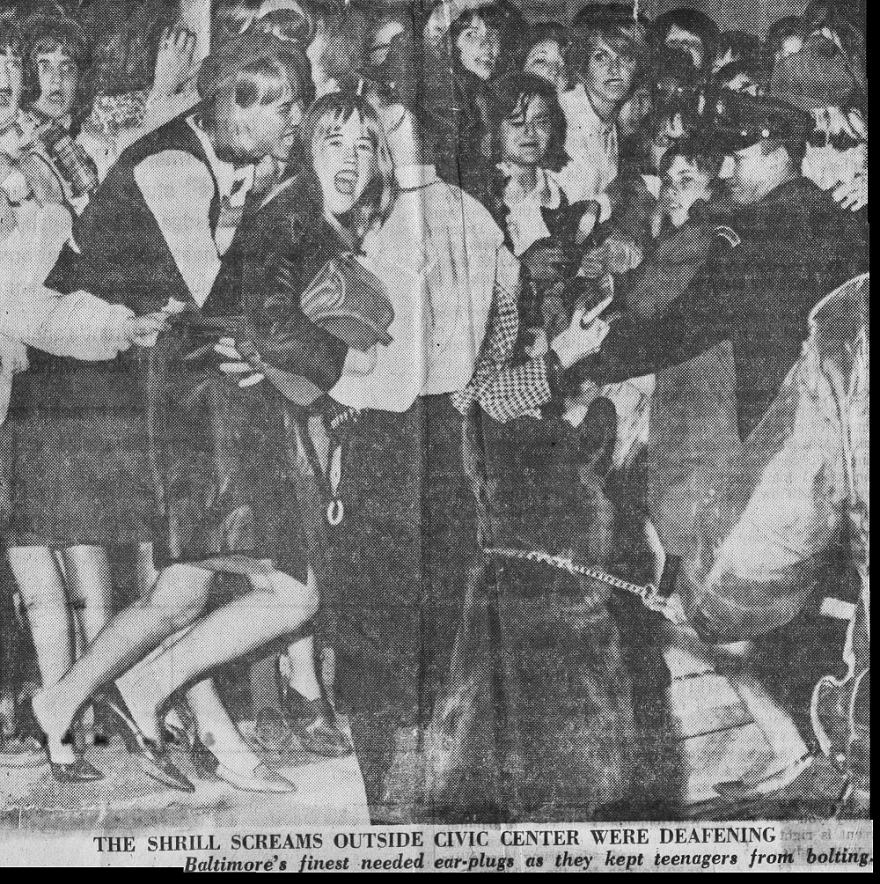
Photo courtesy Sgt. George T. Owens
Officer George T. Owens's seen here at the Civic Center (the patrolman on the right hand side in the jacket) working crowd control when the Beatles came to Baltimore. September 13, 1964
| Photo courtesy Sgt. George T. Owens |
Officer George T. Owens seen here patrolling his post. 1964
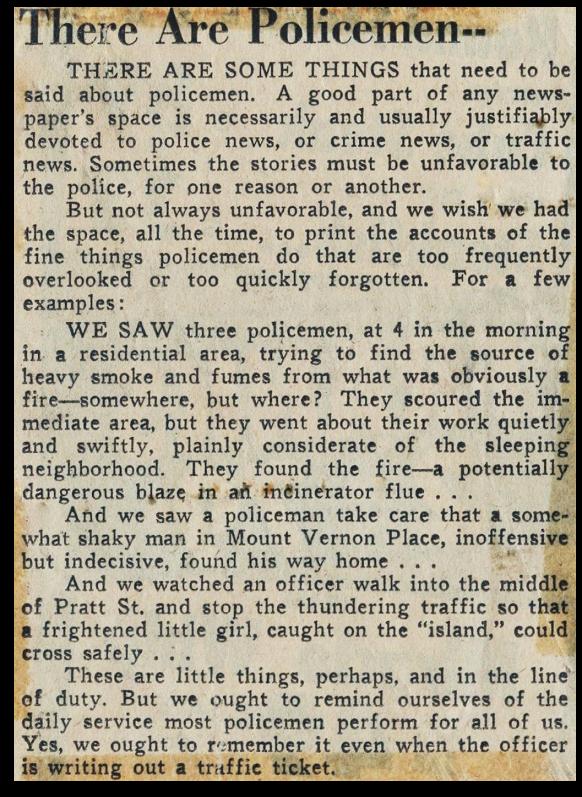 |
| Photo courtesy Sgt. George T. Owens |

Officer Joseph B. Huffman 1965
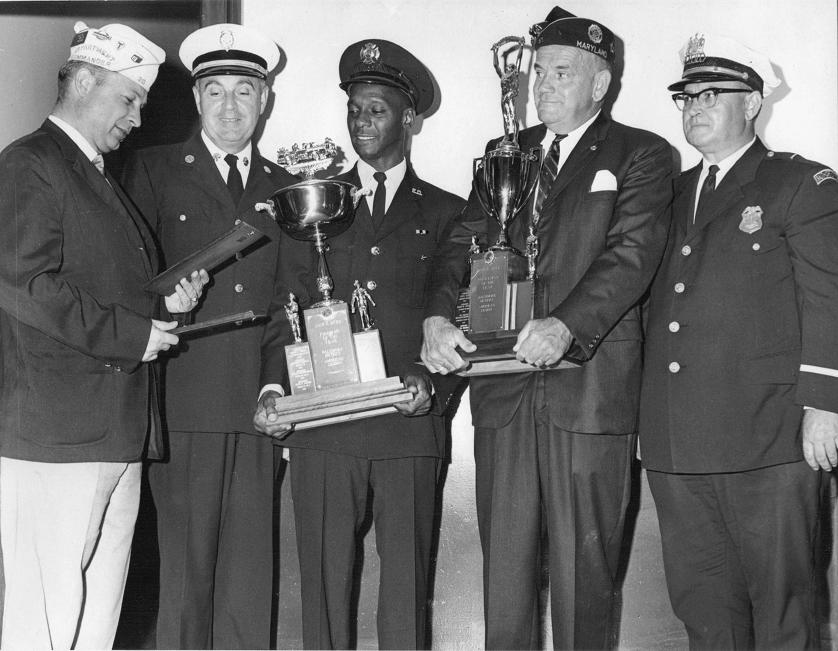 |
| Photo Courtesy James Redding |
Lieutenant Clyde Redding (far right) BCPD Officer of the Year 1966
along with the BCFD officer of the year 1966
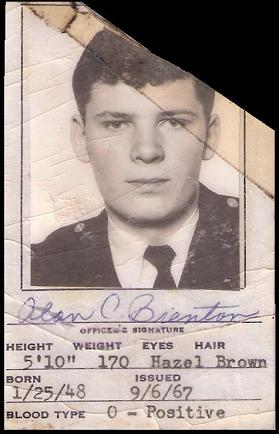
Courtesy Wally Brenton
He served in the Southeast District 1967-1973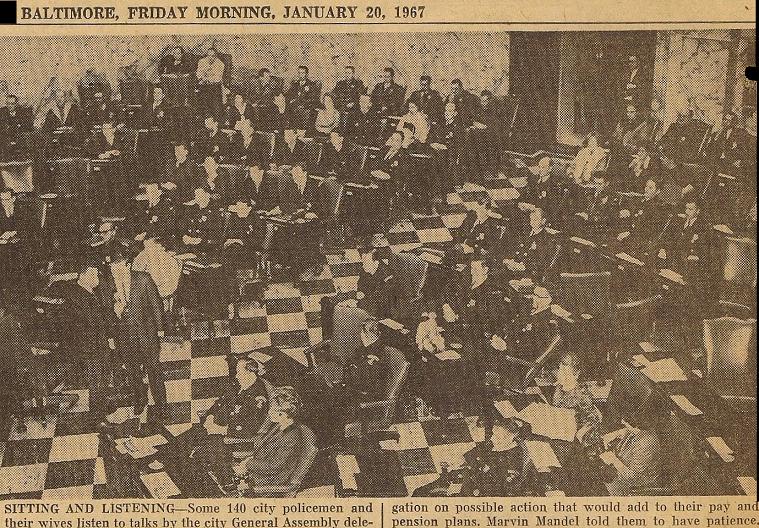
Photo courtesy Officer Bill Hough
Baltimore Police Officers and their wives listen to Govenor Marvin Mandel who promised raises and told them to just have patience
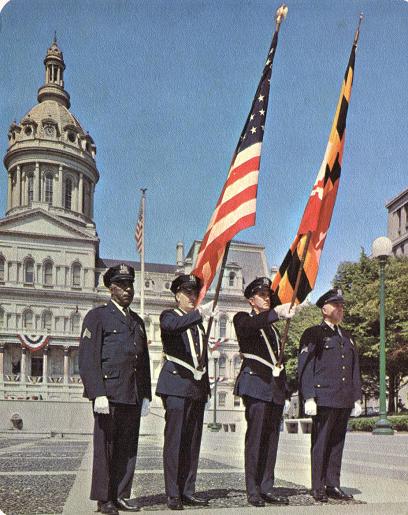
Honor Guard 1968

Photo courtesy Rhonda Owens
Officer Wiley Melvin Owens Jr.
Badge #2928
Later promoted to Detective and assigned ISD
Passed away December 1, 1973
He was an honest, dedicated, faithful member of the force who served the community valiantly.
< class="mce-object mce-object-undefined">
Officer Wiley Owens Jr. was offered a $100.00 bribe to change his testimony in a drunk driver case by defense attorney Jackson Dulaney Pennington ,but Officer Owens maintained his integrity and promptly reported the incident. November 13, 1969

Photo courtesy Rhonda Owens
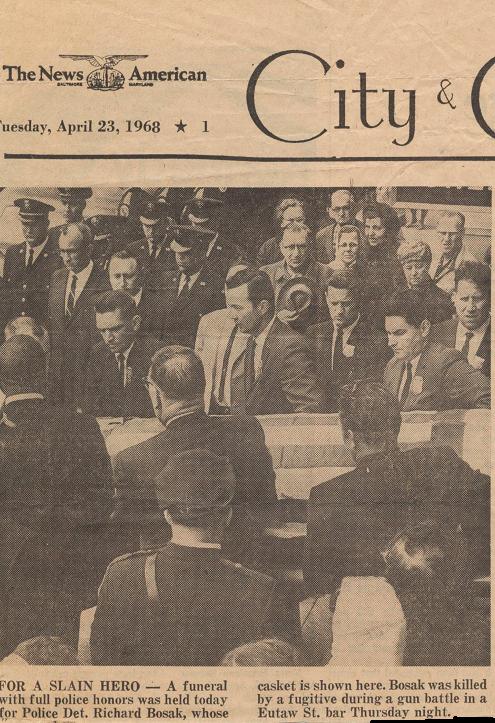
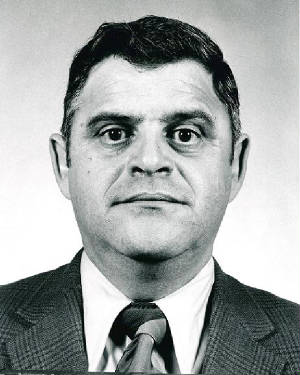
Sergeant Francis Max Gutierrez
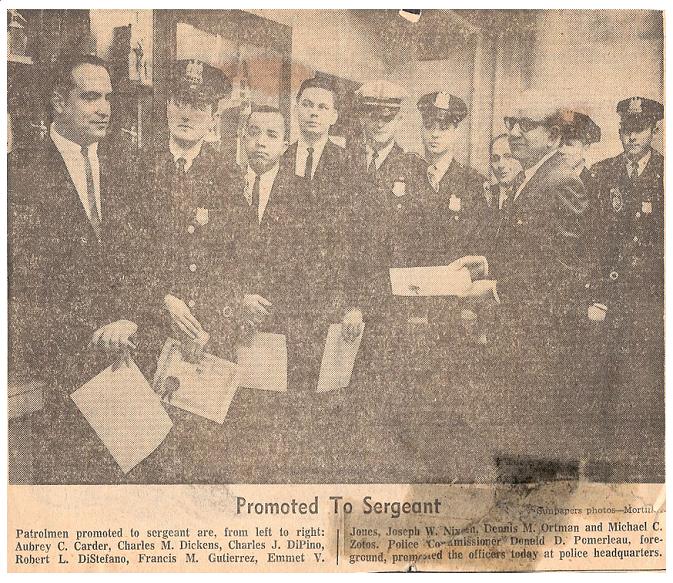
COURTESY JOSEPH GUITERREZ
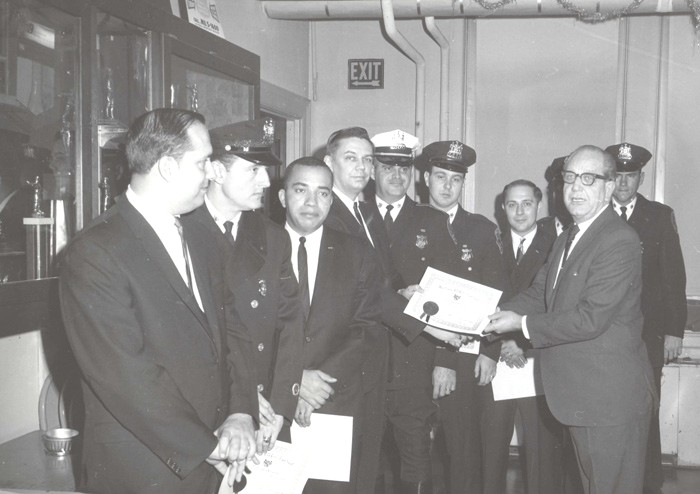
COURTESY MAJOR ROBERT DiSTEFANO
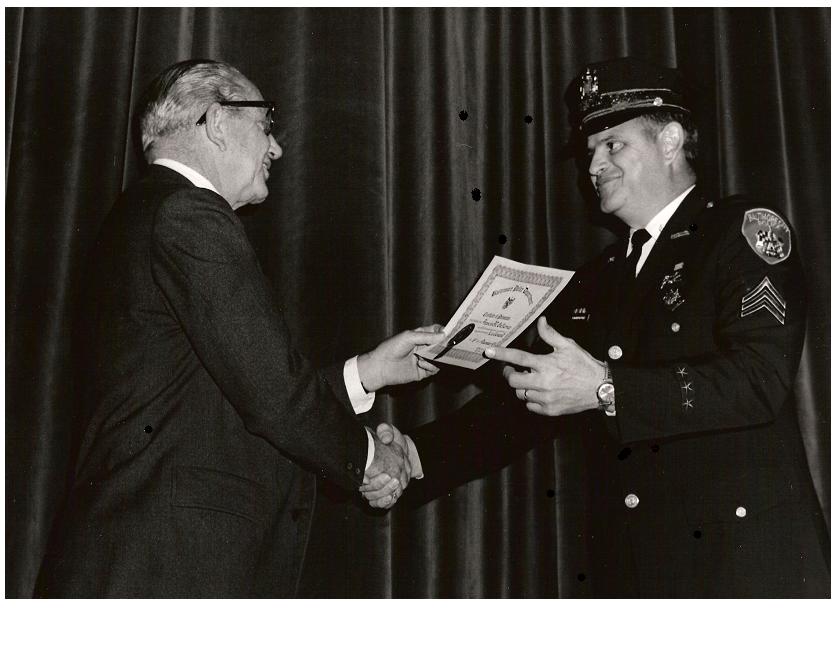
COURTESY JOSEPH GUITERREZ
Sergeant Gutierrez receiving his certificate of promotion to Sergeant from Police Commissioner Donald D. Pomerleau 12/26/1968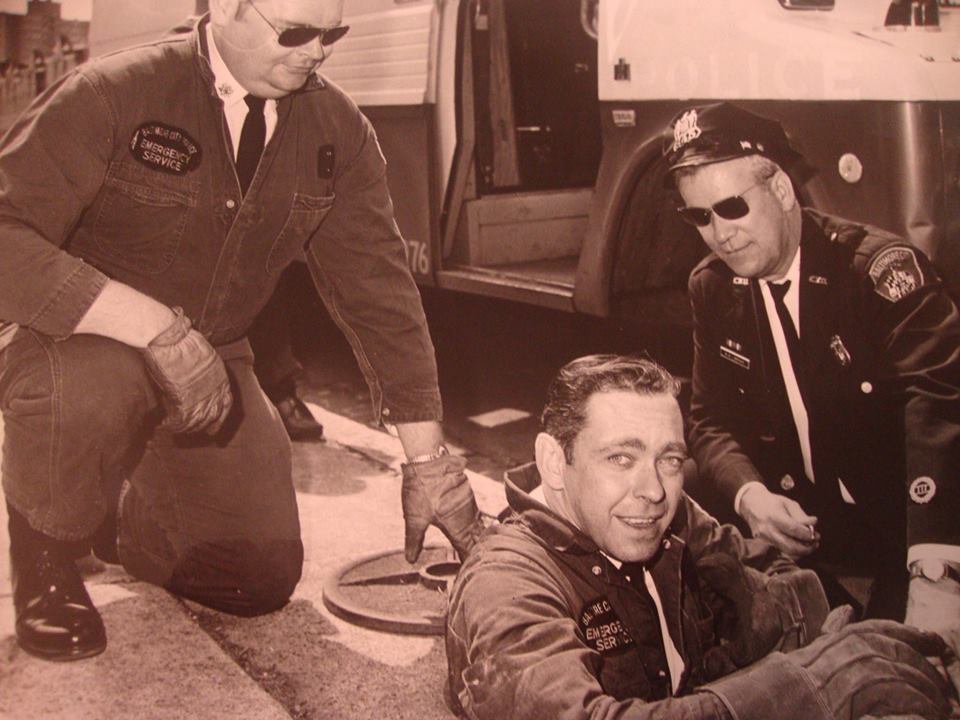
Courtesy Det. Mark Lindsay
Blast from the past: Officer Howard "Bud" Lindsay Officer John Scales and Bob Fisher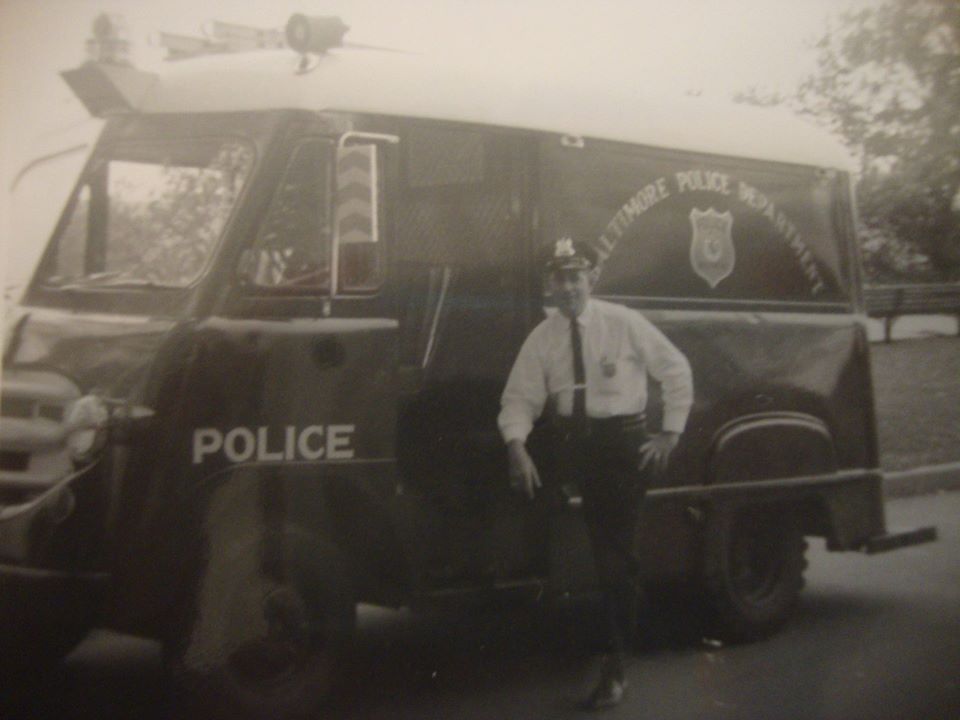
Courtesy Det. Mark Lindsay
Ellis "Ditty" Baldwin
Notice the word "City" isn't on the truck! City, wasn't removed from "Baltimore City Police" until the mid, to late 70's as the Mayor at the time was transitioning Baltimore into a Tourist town, Building the Inner Harbor, and wanted to remove the tough sound of City from Baltimore, but that all came much later than this truck. This was a sign of thngs to come.
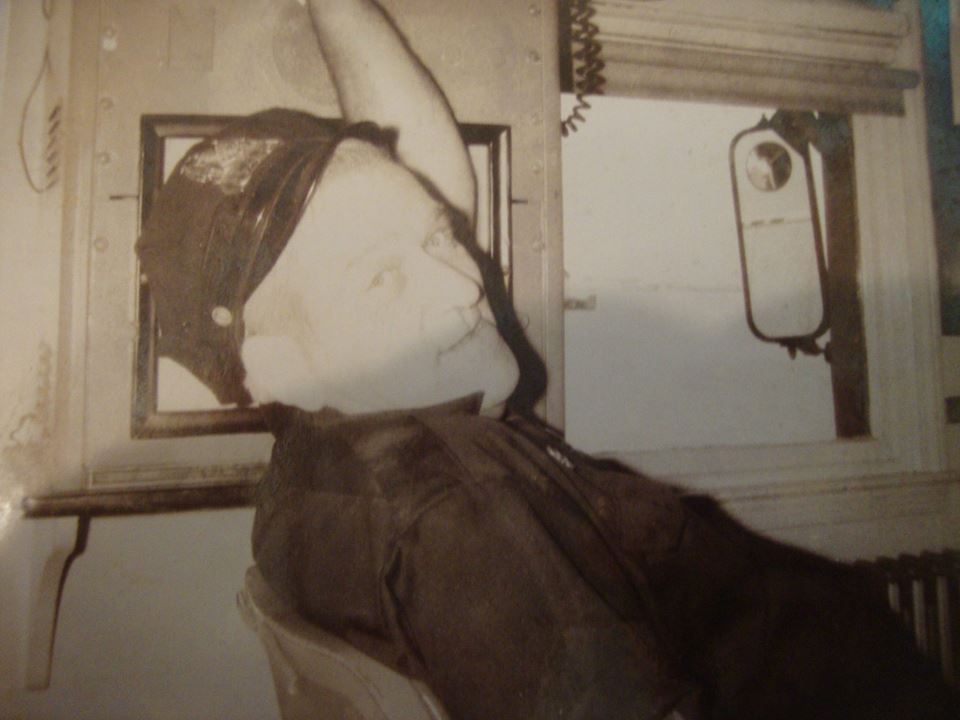
Courtesy Det. Mark Lindsay
The "Command Chair" at 1050 S. Broadway. Notice the mirror and fish eye mounted on the window frame. Very useful to detect sneaking bad guys, and duty officers.- When the uniform cap was worn on the truck, it was wise to remove the inside wire in the top portion, (Known by some as the stylish "50 Mission Crush" of the hat) Otherwise, the wind would blow it off and out of the truck), Mine (Michael Roselle) was run over by some wise guy in a Buick. The guy was last seen driving east on Fayette from Central laughing.

Courtesy Det. Mark Lindsay
John Scales and Bud Lindsay with a recovered possible 81mm mortar round or a 122mm rd.
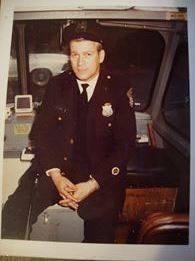
Courtesy Det.Mark Lindsay
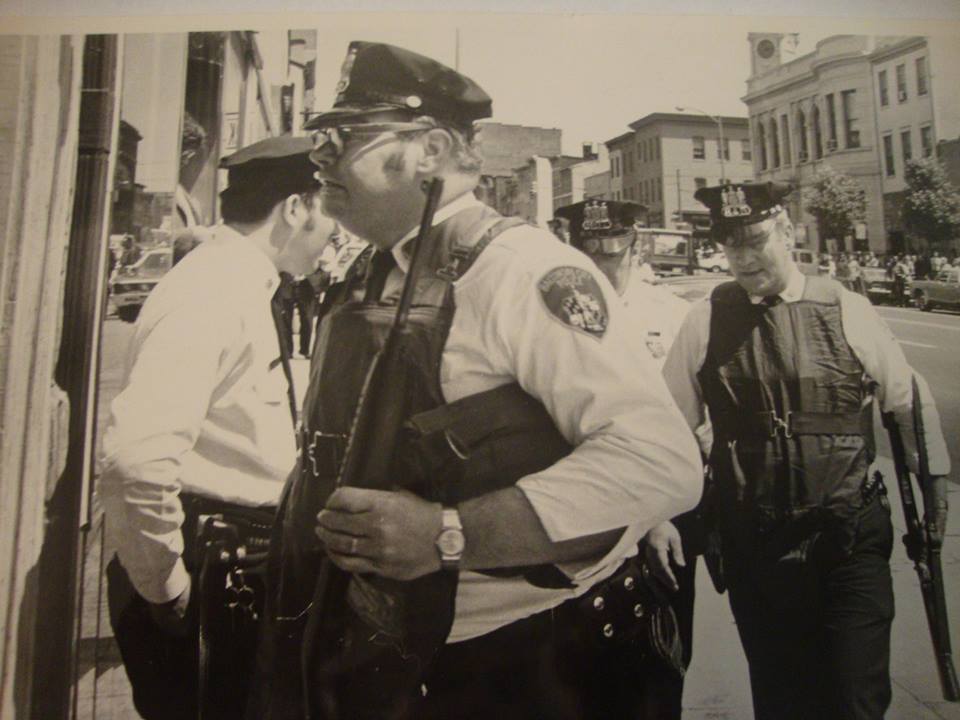
Courtesy Det. Mark Lindsay
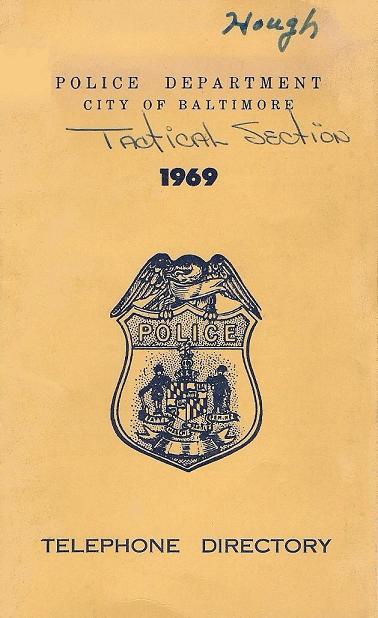
Photo courtesy Officer William hough
Front cover of the 1969 departmental phone book

Original Certificate of Retirement
John N. McCormick
25 years of dedicated service
1943-1969

Flag draped casket of Officer Donald Sager
April 24, 1970

Shriner's circus detail 1970's
with one of the circus performers
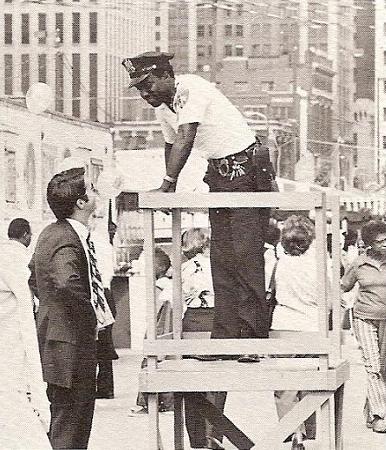
The following several pictures are at the Baltimore City Fair in the late 1970's

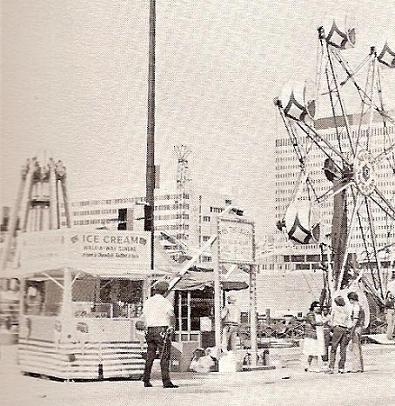
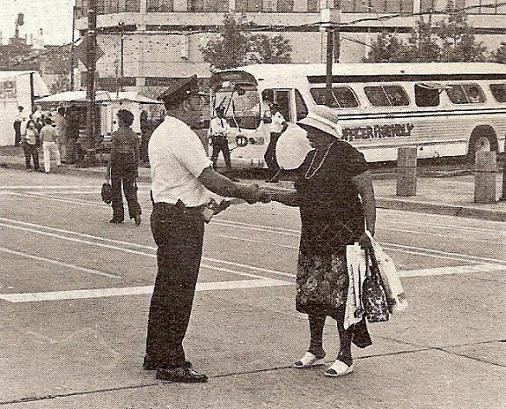
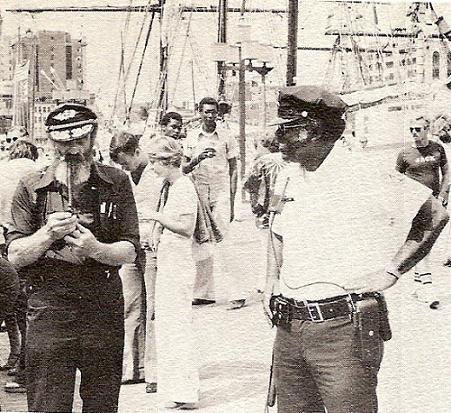
MORE POLICE TRAINING SET
KIRK SCHARFENBERG
The Sun (1837-1989); Jun 25, 1968; pg. C8
MORE POLICE TRAINING SET
Schooling of All Recruits
In State to Rise 50%
Ocean City, June 24-The executive secretary of the Maryland Police Training Commission said today that by this fall the length of the mandatory training period for recruits on police forces around the State will be increased by 50 per cent.
Robert L. Van Wagoner told members of the Maryland Municipal League, meeting at the Commander Hotel here that the planned increase in, hours of training from 160 to 240 will make the Maryland program among the most thorough in the country.
He also told the group that, within a year, officers entering training schools run by his commission will have to pass intelligence and stability tests.
Determining Tests
Mr. Van Wagoner said the commission is now working with the University of Maryland to determine what specific tests will be used.
State law, he said, requires all men recruited by police forces throughout the State since June 1, 1967, to pass a training course approved by the commission.
The course must be completed within a year of the officer's appointment to the police force.
Mr. Van Wagoner said he is "reasonably certain" that there have been violations of the law "though ignorance." But, he added, a new State program, providing $21,000,0110 to local police departments and requiring compliance with the commission's standards, should aid in enforcement of the requirements.
Has Not Used Power
He noted that the commission, composed of leading law enforcement officials in the' State, the attorney general and the president of the University of Maryland, has not yet exercised its authority to set standards for veteran police officers.
He termed this the most difficult aspect of the commission's 1 work, but said that the standards will be set.
Mr. Van Wagoner added, "the large portion of police officers 1 in the Slate have never had an ounce of training and have never shot a gun, except on July 4th.
"Ninety-five percent of the police officers want this training,” he said, estimating that the initial course for veteran officers would probably last a week.
Small Communities
Ile noted that the increased standards for admission to the training schools, which already require a high school education and good character references, may work a hardship on small communities which have difficulty paying their police forces even now.
He suggested, therefore, that these communities use the State money they receive to improve their police salaries to hire qualified men
"It's no good to have equipment if you don't have the qualified men to operate it," he said.


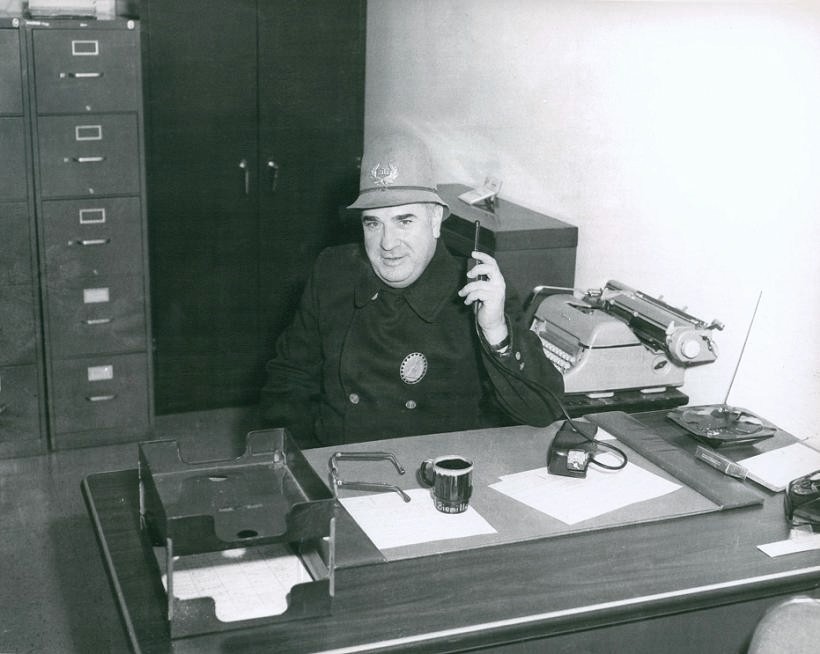
Photo courtesy Det. Charlie Smoot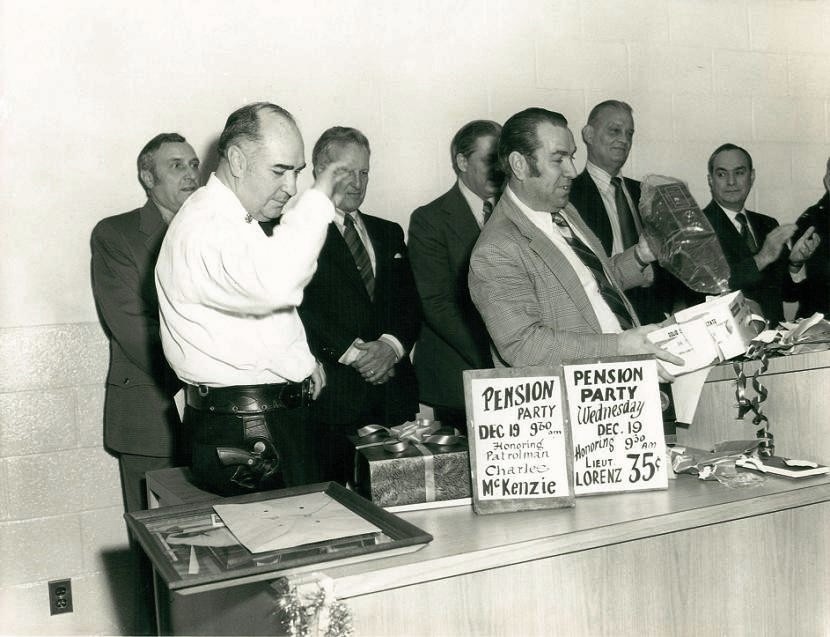
Photo courtesy Det. Charlie Smoot
Officer Lawrence Barry ( white shirt) is seen here attending a retirement party.

Officer Vernon G. Barclay
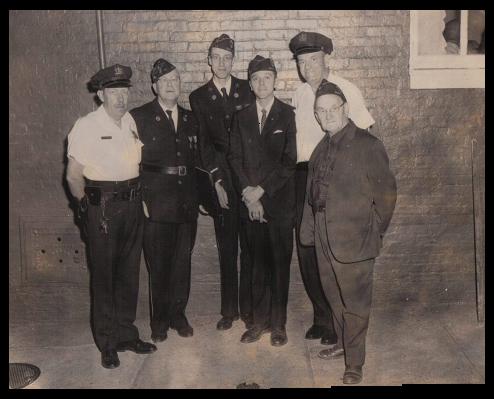
Officer Charles Thompson (left)
Officer Clyde Redding (right)
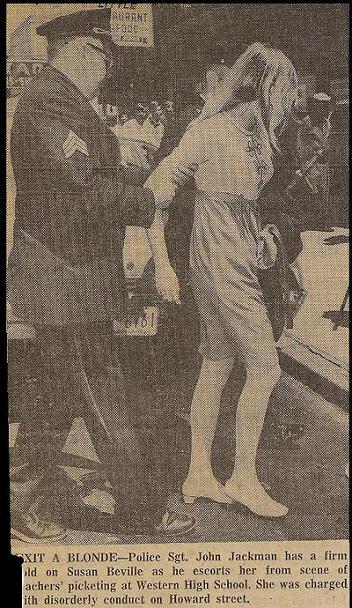
| Photo courtesy Officer Bill Hough |
Sergeant John Jackman escorts a prisoner from a disturbance at western High School
 |
| Photo courtesy Officer Bill Hough |
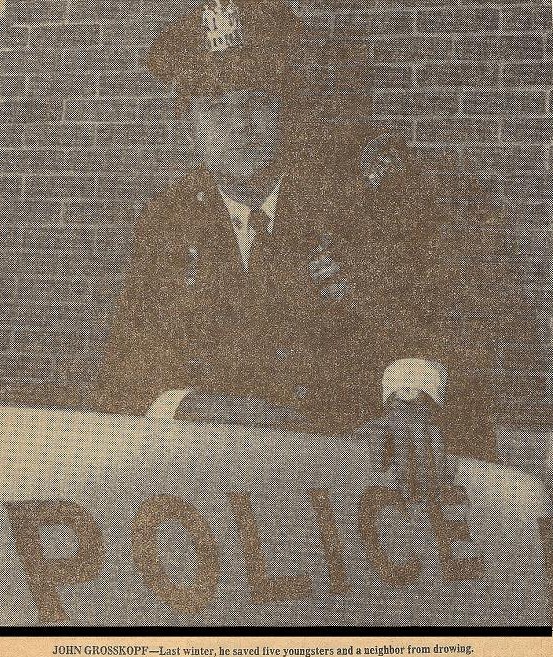 |
| Photo courtesy Officer Bill Hough |
Officer John Grosskopf "Hero" saved several children from drowning
 |
| Photo courtesy Officer Bill Hough |
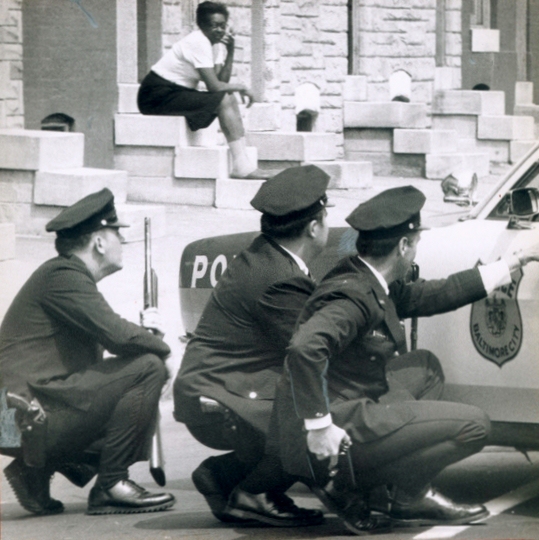
Black Panther raid 1700 blk. N. Aisquith St.
April 30, 1970
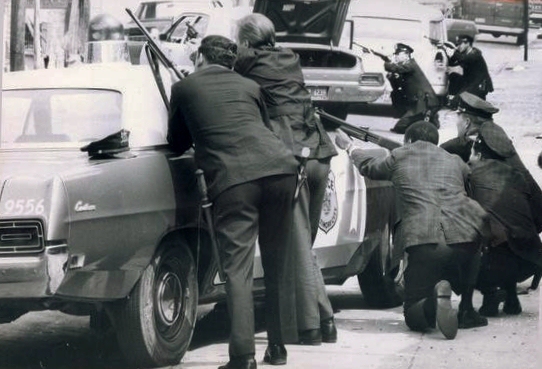
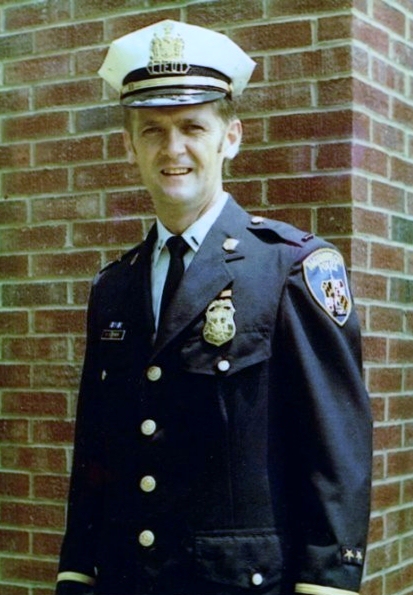 |
| Photo Courtesy Lieut. William Bowen |
Lieutenant William Bowen
1972
 |
| Courtesy of Officer Dick Busch |
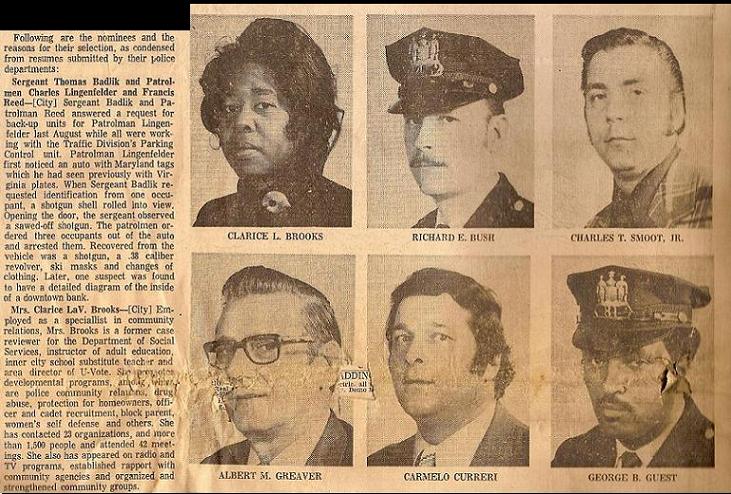 |
| Courtesy of Officer Dick Busch |
 |
| Courtesy of Officer Dick Busch |



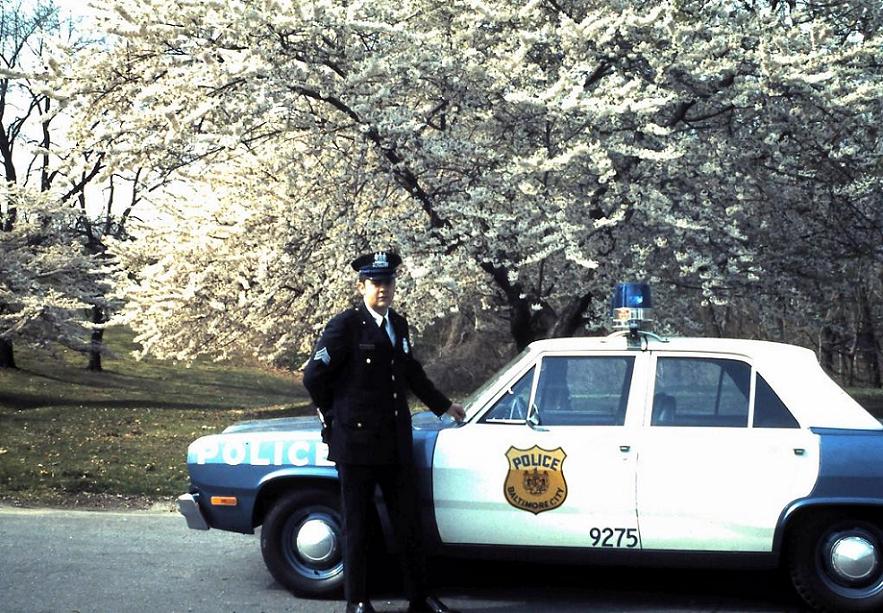
Sergeant Robert Wilson working Druid Hill Park 1970's in a Dodge Aspen

Photo courtesy Lieut. Robert Wilson
Photo courtesy Lieut. Robert Wilson
LAWS & LIBERTY
The Sun (1837-1989); Sep 8, 1974; pg. AA29
LAWS & LIBERTY
The increasing pressure of traffic particularly in the downtown sections of our great Babylon’s and Gomorrah, has at least one laudable effect: it makes the police happy. Naturally pedantic, and trained, the pedagogues, in the doctrine that all human beings are precisely alike and maybe handle stalks of weed, BB shot Hall at the stockyard, they delight in the opportunity to make and enforce ever more complex and nonconsensual regulations.
The other day I read in the Sunpaper that so many motorists were herded for trial in a traffic court that it took three judges to dispose of them... Obviously, the police, like Judge Elbert H. Gary, have no need to wait for heaven; they enjoyed here and now. What could be more charmingly to their taste than a body of laws which fills two courtrooms suffocation every day, and keeps three judges leaping and tugging back fire engine hoses the situation is made the more intoxicating by the Attacked that 9/10 of the criminals or persons who would not otherwise fall into the toils – the traffic regulation tap whole new categories of victims...
The United railways [which ran the public transportation system] has ably seconded the police in this gradual disciplining and regimentation of the people of Baltimore... Today riding on the cars of uniting railways is indistinguishable from running a gantlet. The passenger is no longer a customer, nor even an individual; he is simply an anonymous unit in an endless chain – a sort of sausage fed into an insatiable and impersonal maw. His desires are no more regarded than if he were a corpse. The instant he steps of a board a car the cogs and levers of the machine grip him, and thereafter until he escapes, he is a sleeve. He must deposit his fair at a certain time and place; he must move as ordered; if he happens to be smoking he is in for a sharp reprimand. All his old rights now reduce themselves to one: he may get off if he doesn’t like it, and be damned... Meanwhile, the company hires in psychology at $50,000 a year and expense to improve its public relations – that is, to diminish the climber that goes on against it all the time. No wonder there is a climber. Don’t the halls in the slaughterhouse wheel?
The Evening Sun March 23, 1925
it takes a very powerful effort of the will and imagination for any reflective man, in these last days of the Republic, to be proud that he is an American; those who seem to be the proudest of it, indeed are precisely the worst cads and ignoramuses on view. But all the while it remains relatively easy to be proud of being a Marylander, for here in this little state, stuck forlornly between the serfs of the North and the slaves of the South, there remains in active being a great deal of the genuine liberty of the braver and more expansive day, and what is better still, there is not slightest sign that in so far as the people of this state can control the matter, it is distinguishing. Period.
Maryland is one of the few free states left in the American Commonwealth – almost, indeed, the only state remaining in which the guarantees of the Bill of Rights has served the roguery of legislators and imbecility of judges...
This respect for human rights – this quick resentment of every appearance of official bullying – remains alive in Maryland because of the survival of an older tradition of freedom. But perhaps that tradition itself survives because of something that is too often forgotten, to wit, that in Maryland the jury in a criminal case is a judge of the law as well as the facts. It would be difficult to overestimate the importance of this constitutional safeguard. On the one hand, it instantly draws teeth of the foolish and oppressive laws… And all the other hand, it makes it almost impossible for the police to make law on their own book, and railroad innocent men to prison, as has happened so often in California and other Western states, and of late even in New England…
Liberty is a great deal less esteemed in America that used to be; the other day the American ambassador to Rome was deriding it as archaic. But here in Maryland it is still respected, and that single fact is worth more than all the sugar refineries, Tanneries, guano factories and other such great dunes that go-getters will bring to the state between this day in the day of judgment.
The Evening Sun, July 31, 1923
This is one of the few American states which, in the state courts, constitutional guarantees of the citizen are jealously guarded. Unlike New York, Pennsylvania, and most of the Western states, we have no laws limiting the free play of opinion; and Marylander is at liberty to set forth his honest sentiments, in private or in public, without interference by the police no so-called soapbox or, however extravagant and idiotic, has ever been sent to prison in Maryland.
The Evening Sun, September 22, 1924
Eugene Grannan, who died a week ago, was one of the town characters of Baltimore at the end of the last century, antique His peculiar color and charm to the end… He was… A man almost ideally fitted for his job [of police magistrate]. For years a professional detective, working for the Baltimore and Ohio Railroad, he knew familiarly most of the petticoats working in these parts. More common a new policeman, and could read their peculiarity innocent minds. Yet more, he was a man combined great shrewdness and an expansive sentimentality in a way that is very rare to this world. Finally, he had a vast untapped for lawyers, and scarcely less for the law…
Grannan first came into public notice by a devastating attack upon the old system of intrigue which for years had made criminal justice a mockery in Baltimore. He was then sitting at the Western police station on Pine Street, and his bailiwick included the nearby red light district. The girls in that district were frequently in conflict with the police, and so most of them got themselves protectors of political influence – naturally enough, a worthless and the last class of men. Sometimes these protectors will get drunk and beat the girls. The police would then lock them up to prevent murders, but in the morning they were commonly turned loose without punishment.
But soon after Grannan went up on the bench such as scoundrel appeared before him, and, in violation of the immemorial practice, he called for the witnesses and proceeded to trial. The evidence was plain enough. The fellow had got drunk and given his girl a beat. He now stood before the bar with Democratic ward leader of that vicinity on one side of him, and the group of gaudy brethren of his craft on the other. He plainly expected the usual humane treatment. Disdaining a jury trial, he elected to be tried by Grannan. Grannan found him guilty and sentenced him to two years in the house of corrections…
This episode made Grannan a town celebrity, and the notion got around that he was a crusader against politicians, and eager to get all of them into prison. He was, of course, nothing of the sort. On the contrary, he knew very well that politicians serve a very useful purpose, especially of the more petty varieties, and he made constant use of them in his work...
His attitude toward policeman was much the same. He knew that 9/10 of them was simpleminded honest men, but he also knew how much professional prejudice: their thoughts… He was thus very suspicious of constabulary testimony, and seldom accepted it unless it was supported by disinterested witnesses…
The life of such a man, it seems to me, is immensely valuable to the community he lives in, and he ought to be remembered. There was nothing brilliant about Grannan… But he had qualities that were of high social work and excellence, and chance threw him into a position where they could be utilized effectively and made to yield permanent benefits. He founded a whole school of police magistrates, obviously better than the old school… And his influence, I believe, as it towered to this day.
What made him attractive personally was his pawky and sardonic humor. He greatly enjoyed his work, despite the foul smells of his court and the daily contact with wretchedness in all its form, and always kept it on a level of amiable tolerance. Time and time again I have seen him dissipate misery with a jocosity. He loved to scare minor offenders horribly, and then turn them loose. Once an old German was before him, Charles was quarreling with his wife of 40 years. Both parties will repentant and ashamed. Grannan solemnly tried the old man, sentenced and 25 years in the penitentiary, and then, after the cops had revived him since him is way, his wife on his arm. He ordered the case to them from the books and asked the reporters not to mention it…
The only time I ever saw him show anger on the bench was one in E. Baltimore St. missionary came before him, charging an ancient Russian Jew with assault. The missionary, it appeared, had dragged the Jews grandson into his gospel all, and tried to convert him to Methodism. Grannan, usually very dignified on the fence, lost his temper and gave the missionary a dreadful cursing. Then he turned to the Jew. “I am glad you feed him,” he said, “but don’t do it again. The law is an ass, but it has two years. The next time he tackles your grandson, bring him here.”
The Evening Sun, September 6, 1926
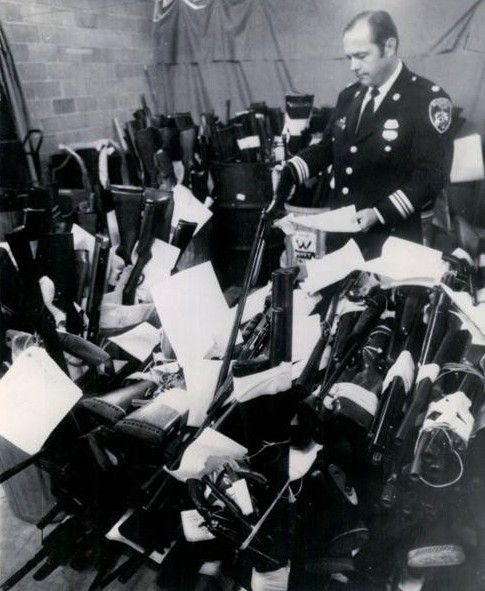
Baltimore City initiates a Gun Buy Program August 1974
Major John Kollmann stands amid some of the 1,000 guns that the City bought at $50.00 each from City residents, no questions asked, as an incentive to rid the City of guns. 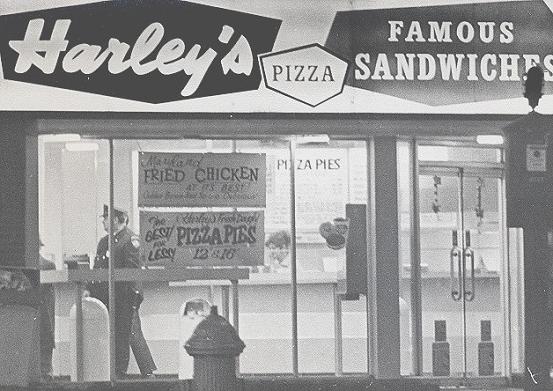
COURTESY SERGEANT BERNIE WEHAGE
Officer Warren Todd Central District R/C 102 on a business check at Harley's,
Liberty & Fayette Sts.
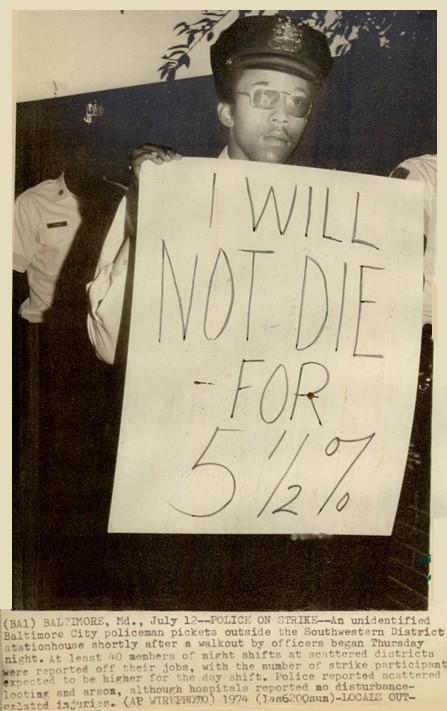
BALTIMORE POLICE STRIKE 1974
A dark time in the history of the Baltimore Police Department.
The first police strike in a major City since 1912.
A Civil War, BPD Officers vs. BPD Officers.
The strike became a part of our history and for all law enforcement.
It was not a proud moment for the Baltimore Police Department.
Many BPD officers were in a state of conflict, do the Right thing or fight
for a cause they truly believed in. No one won in this conflict.
Scars were left and will be a long time healing.
They will, indeed, heal. May this never happen again in our history.
May our ranks stay united as a brotherhood.
Officers working together for the benefit of all.
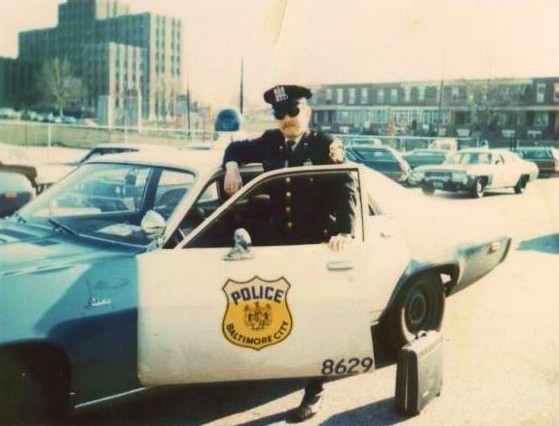
Officer Paul Bach standing next to a 1974 Plymouth in the SED parking lot
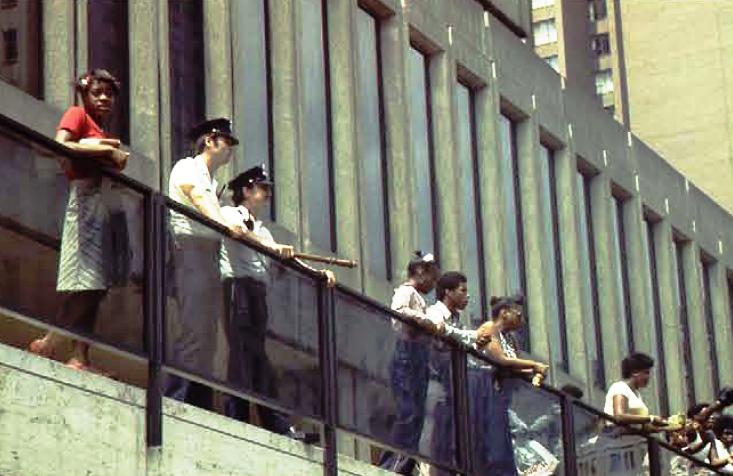
Officer William Hackley(L) and Officer Joe Snyder NWD detailed to the Afram Festival
1977
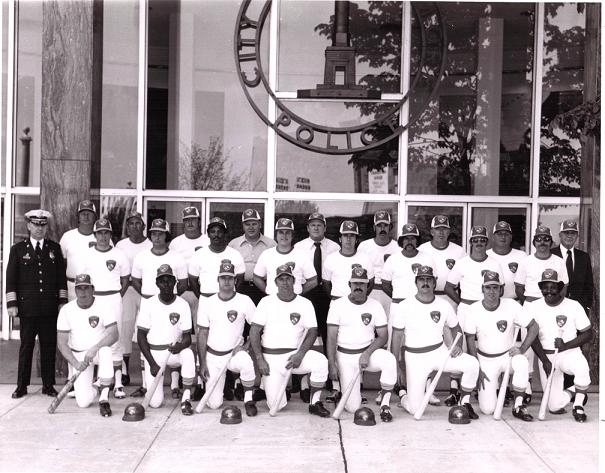
Officers in UNITY 1978
Courtesy Lt.Tom Douglas
Commissioner Donald D. Pomerleau appoints Officer Tom Douglas to Police Agent June 15, 1977
(Below) Commissioner Pomerleau with Newly appointed Agent Tom Douglas with his parents Sue and Doug proudly looking on.
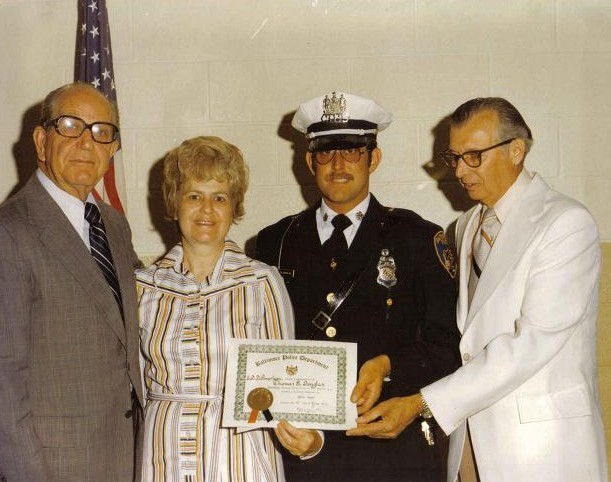
Courtesy Lt.Tom Douglas
COURTESY OFFICER JOE WICZULIS
Photograph of Colonel “Dick” Francis that was given to Officer Marion Wiczulis for Good Luck (above)
COURTESY OFFICER JOE WICZULIS
During the Custom Motorcycle Show held March 1977, at the Timonium Fair Grounds, Officer Marion S. Wiczulis of the Enforcement Section of the Traffic Division and his fiancée,Paula, devoted his spare time to display one of the Department's motorcycles and also helped promote motorcycle safety in conjunction with members of the Baltimore County Police Department.

Major Patricia Mullen, Sergeant Mercedes Rankin, Carol Channing 1978
THE BALTIMORE POLICE DEPARTMENT'S GANGBUSTERS
June 1975
Front Row: Robert Ackerman, SWD; Raymond Gillespie, WD; Richard Boronyak, NWD; Thomas Heathcoate, IID; William Hausner, NED; Michael Andrew, SWD; Martin Hanna, SWD; Leonard Willis, CID; Second Row: Robert Dapp, NED; Anthony Collini, ND; Lawrence Banks, Youth; Gary Childs, CID; Anthony Rinaldi, CD; Clayton Wright, SED; James Griffin, WD; Charles Cichon, NED; Back Row: Colonel Wilbur C. Miller; George Seltzer, WD; William Arnett, Youth; Daniel Markowski, CD; Donald Farley, Youth; Joseph Powell, CID; Robert Thomas, Tac.; Fred Oster, Youth; James Gilbert, CID; Police Commissioner Donald D. Pomerleau.
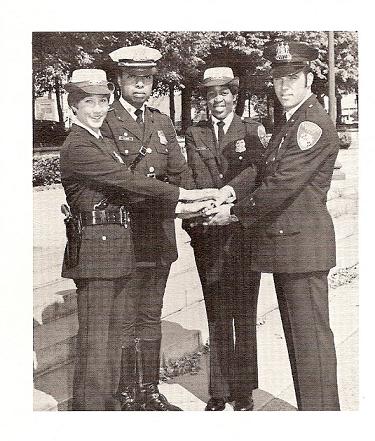

BALTIMORE POLICE NEWSLETTER
Detective Julius Neveker
December 1978

President Jimmy Carter, Major Regis Rafensberger,
Major Ron Mullen, Commissioner Bishop Robinson 1979

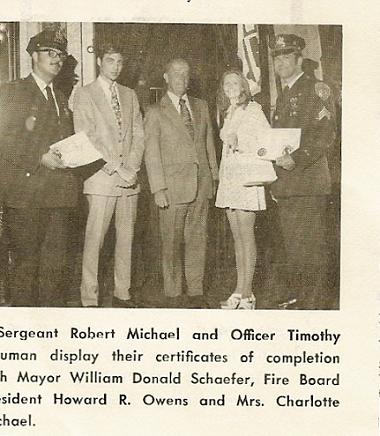
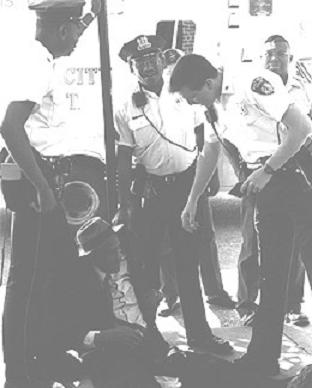

MOTOR POOL OFFICE
Photo courtesy Lieut. Robert Oros
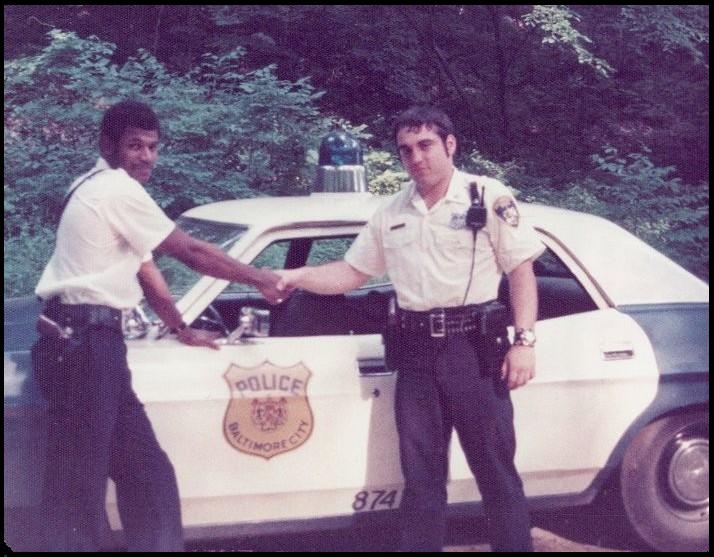

Photo courtesy Officer Brian Beauchamp
Brian W. Beauchamp graduated academy class 70-2 on July 2, 1970, and was assigned to the Northern District, where he remained until he left the department July 11, 1973, and moved to Michigan for family reasons. He started with the Shiawassee County Sheriff's Department in Corunna, MI and retired as a DET/SGT in December 1997
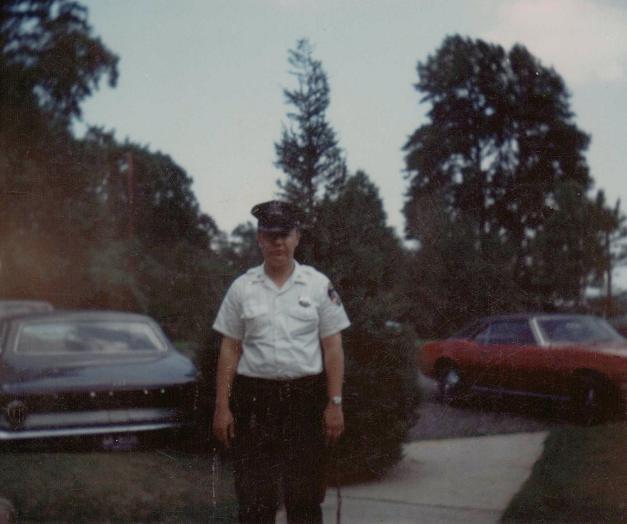
Photo courtesy Officer Brian Beauchamp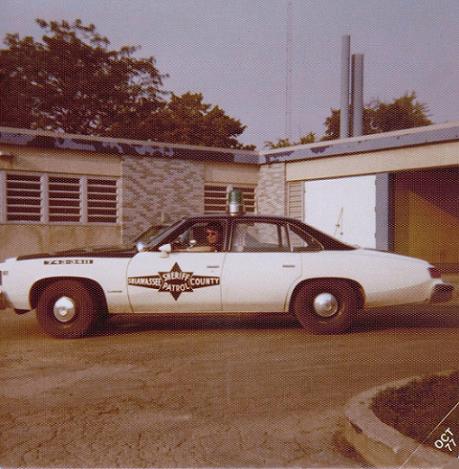
Photo courtesy Brian Beauchamp
Life after the BPD

Courtesy Officer John Brazil
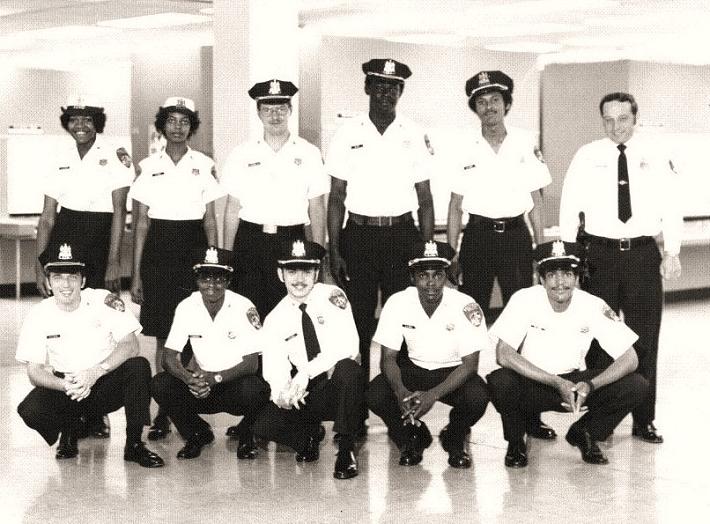
Courtesy Officer John Brazil

Photo courtesy Gary Provenzano
Departmental Accident Shop# 9031
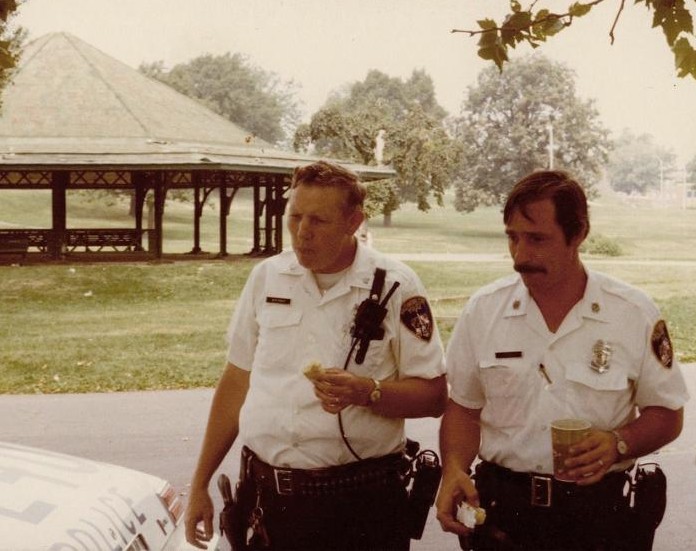
Photo Courtesy Sgt. William Gordon
Sergeant William Staley & Al Bowling celebrating the Sergeant's Birthday (Below) Sergeant Staley enjoys a piece of Birthday Cake 1976
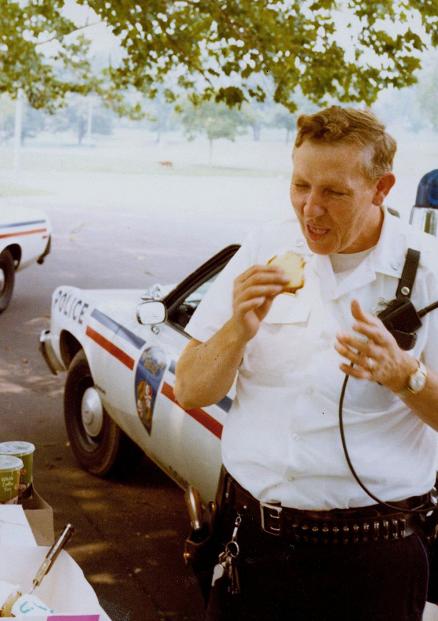
Photo Courtesy Sgt. William Gordon

Photo courtesy: Mary Beth (Peach) Wasmer
Officer Kenneth S. Peach receiving his Sergeant promotion certificate from Police Commissioner Pomerleau
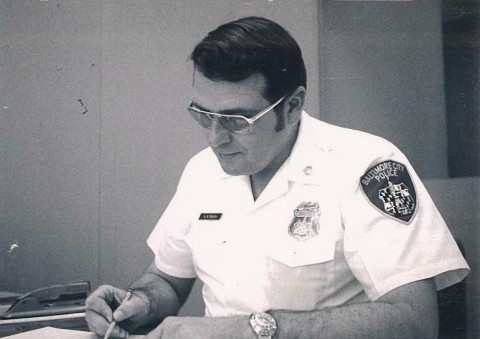
Photo courtesy: Mary Beth (Peach) Wasmer
Sergeant Kenneth Peach hard at work

Photo courtesy: Mary Beth (Peach) Wasmer
Sergeant Peach stops a moment for this photograph

Photo courtesy: Mary Beth (Peach) Wasmer
Sergeant Peach diligently working on a report for the Police Commissioner
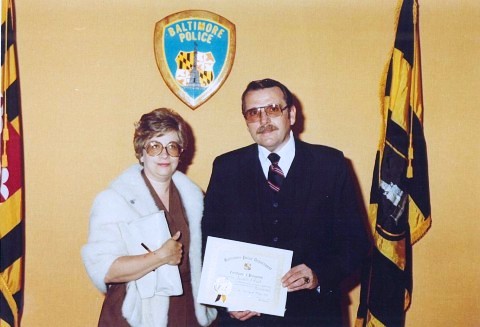
Photo courtesy: Mary Beth (Peach) Wasmer
Sergeant Peach and his wife after receiving his promotion to Lieutenant
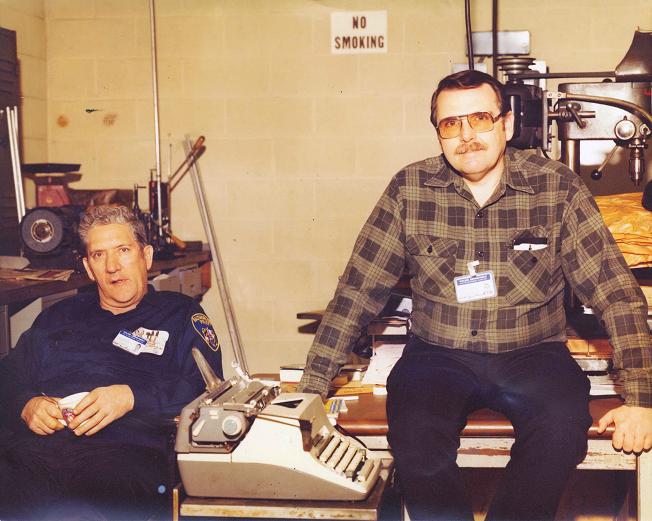
Photo courtesy: Mary Beth (Peach) Wasmer
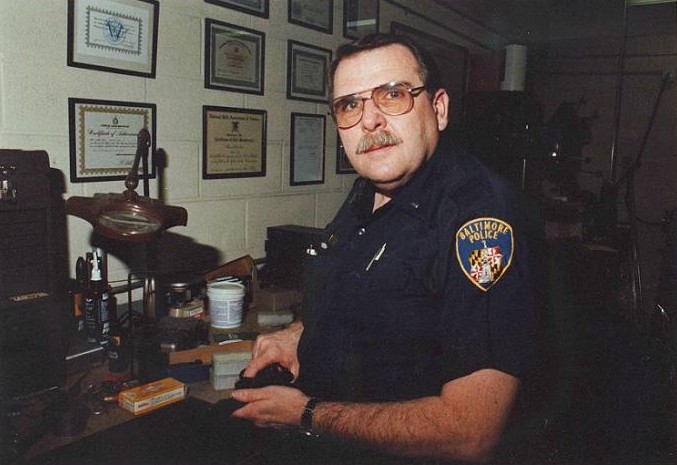
Photo courtesy: Mary Beth (Peach) Wasmer
Lieutenant Kenneth Peach in the Armory Unit
This shot of Lieutenant Peach is probably the most memorable photograph of him etched into everyone's mind. Every visit to the Armory Unit you would find him at his desk thinking and working on some project or working on a gun. He put dedication and pride into his job.
He retired from the department and then passed away very suddenly on February 11, 2007 suffering from cancer. His service to the department is immeasurable and it Honored the Department.
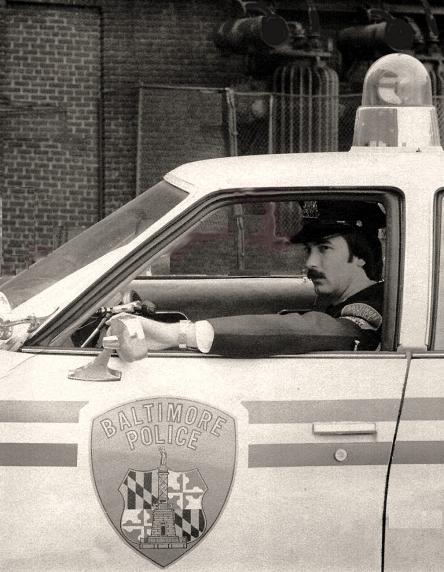
Photo Courtesy Sgt. William Gordon
Officer William Gordon 1977

Photo courtesy Lt. Robert Wilson
Commissioner Donald D. Pomerleau promoting Sergeant Robert Wilson to
the rank of Lieutenant on December 21, 1978. Lt. Wilson with
his wife Lynn and daughters Jessica and Betty Lynn are proud of their dad.
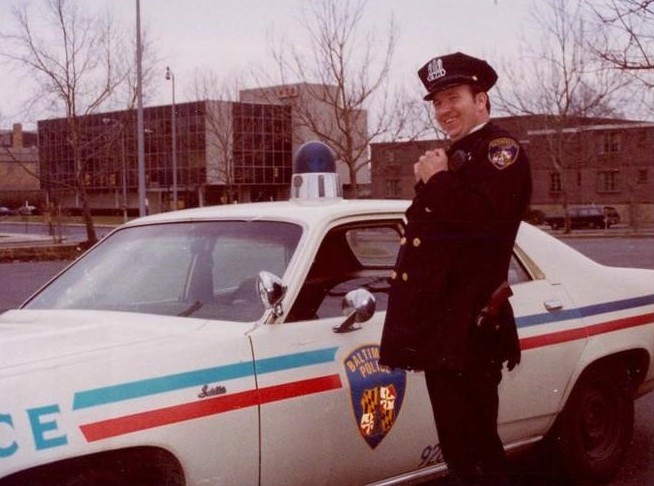
Bobby Ackison
Photo courtesy Lieut. Robert Oros

Photo courtesy Lieut. Robert Oros

Photo courtesy Lieut. Robert Oros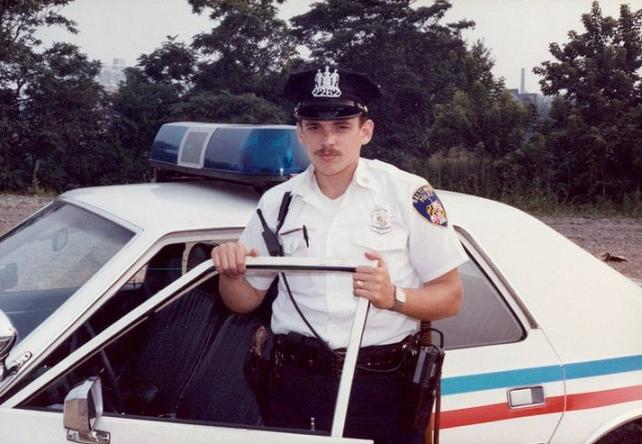
Photo courtesy Lieut. Robert Oros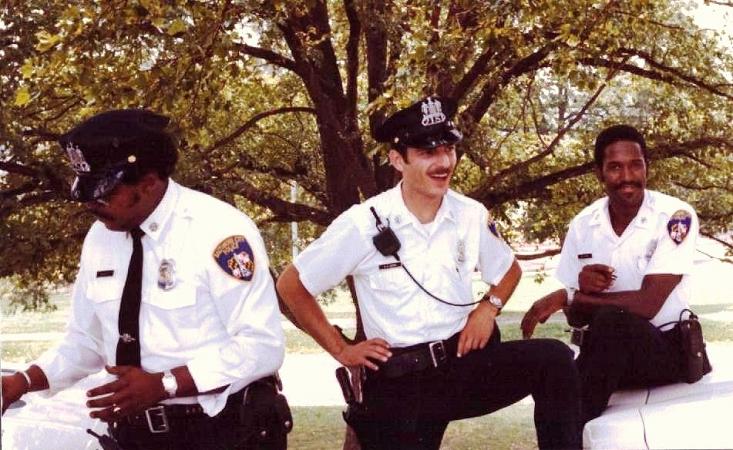
Officer Al Diggs, Don Hoppe, Bob Gains
Courtesy Lt. Tom Douglas

Photo courtesy Christina Bohli, John Drexel's daughter
Deputy Commissioner Harwood Burritt presents Lt. John Drexel a retirement plaque for his 23 years of service.
(Below) Retiring Lieutenant John Drexel stands at the podium with his wife Faye at his retirement party June 1975
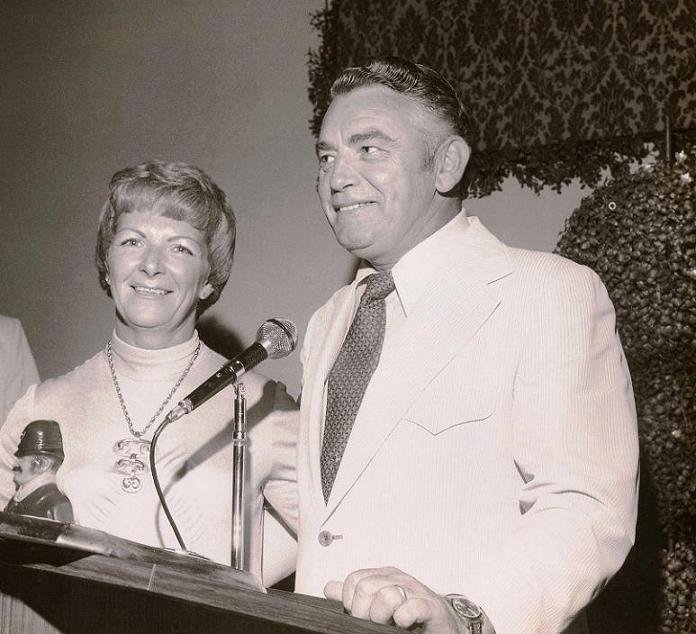
Photo courtesy Christina Bohli, John Drexel's daughter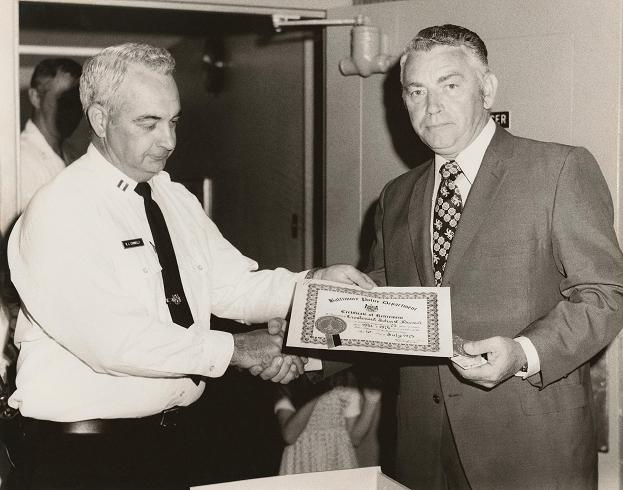
Photo courtesy Christina Bohli, John Drexel's daughter
Captain R. L.Connely giving Lt. John Drexel his retirement certificate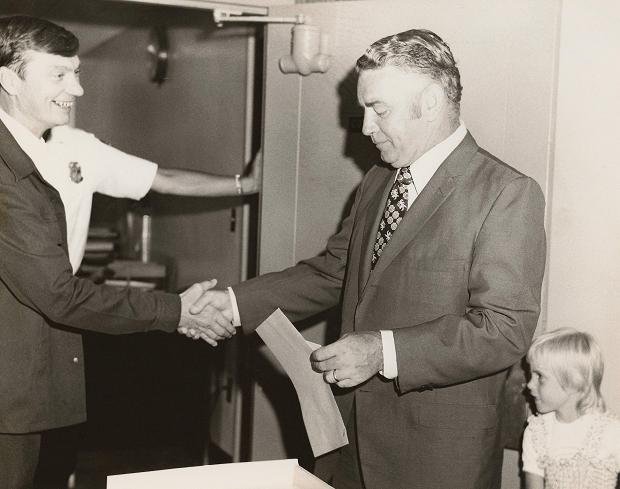
Photo courtesy Christina Bohli, John Drexel's daughter
Lt. John Drexel being congratulated on his retirement while his daughter Christina looks on
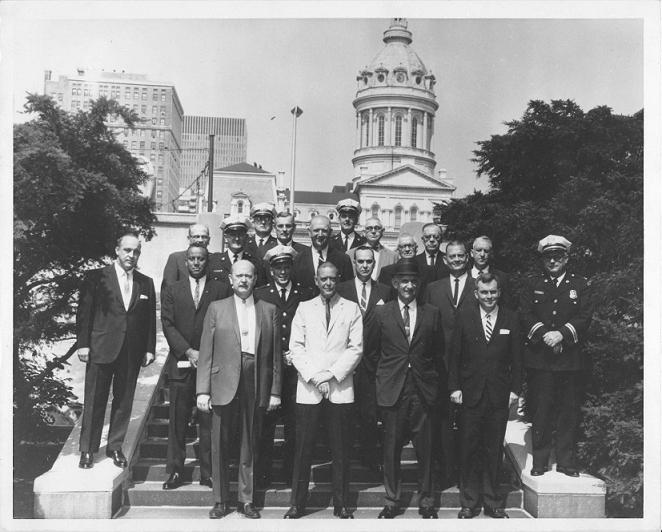
The first row, left to right: Inspector Clarence Kelly, General George Gelston, Inspector George Deuchler. Deputy Commissioner Ralph Murdy.
Second row, left to right: Colonel Richard "Dickie" Taylor, Colonel "Box" Harris. Deputy Commissioner Wade Poole. Inspector Frank J. Battaglia, Inspector Thomas "Tom" Keyes, Captain G. Gordon Gang. Third row left to right: First position unknown to me. Inspector
Frank Deems. Third position unknown to me. Last rows sort of combine. The man with the glasses, peeking out above Box Harris, is Inspector Clarence German. The gentleman in the suit, directly behind Wade Poole I believe is Captain Anthony Nelligan of the Crime Lab. The man directly behind Frank Battaglia is Inspector August Gribbin.

Officer Zawadski, Officer Pat Kirby, Officer K. Council
Photo courtesy Lieut. Robert Oros
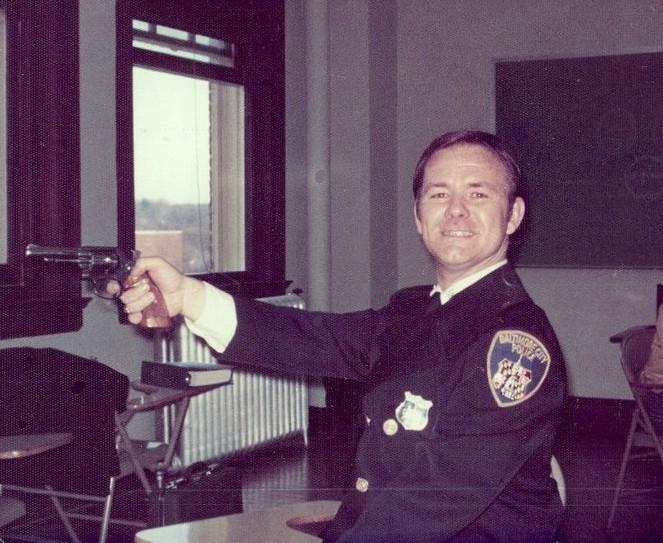
Photo courtesy Lieut. Robert Oros
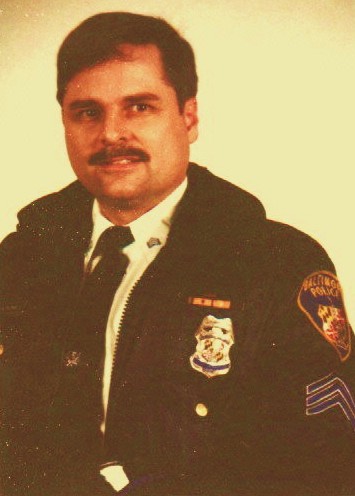
Sergeant George Freeman
COURTESY JOSEPH GUITERREZ
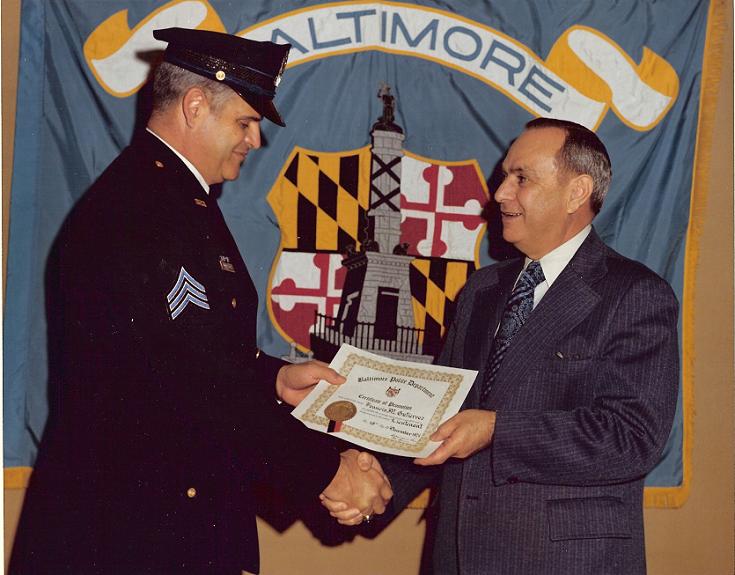
COURTESY JOSEPH GUITERREZ
Sergeant Gutierrez receiving his certificate of promotion to Lieutenant from Police Commissioner Frank J. Battaglia 12/18/1974
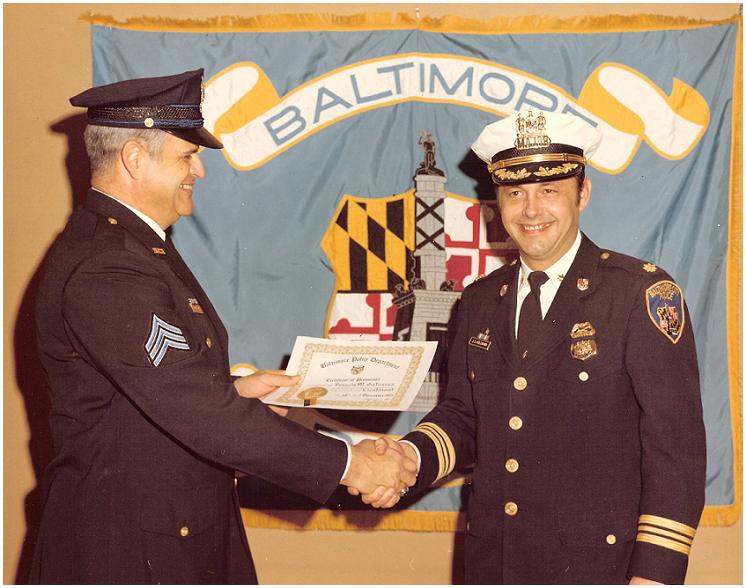
COURTESY JOSEPH GUITERREZ
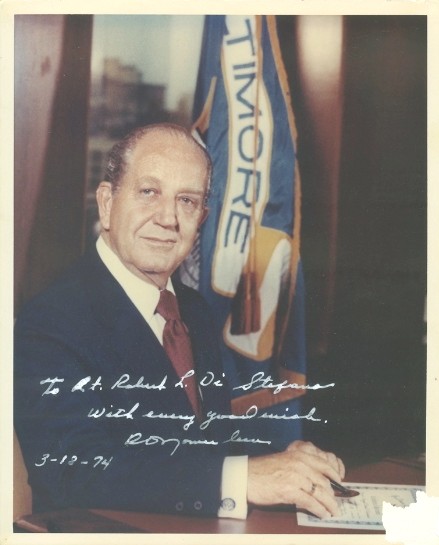
COURTESY MAJOR ROBERT DiSTEFANO
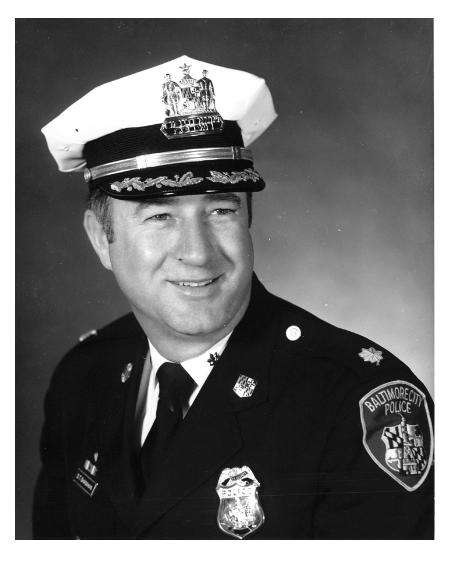
COURTESY MAJOR ROBERT DiSTEFANO
Colonel Donald "Skippy" Shanahan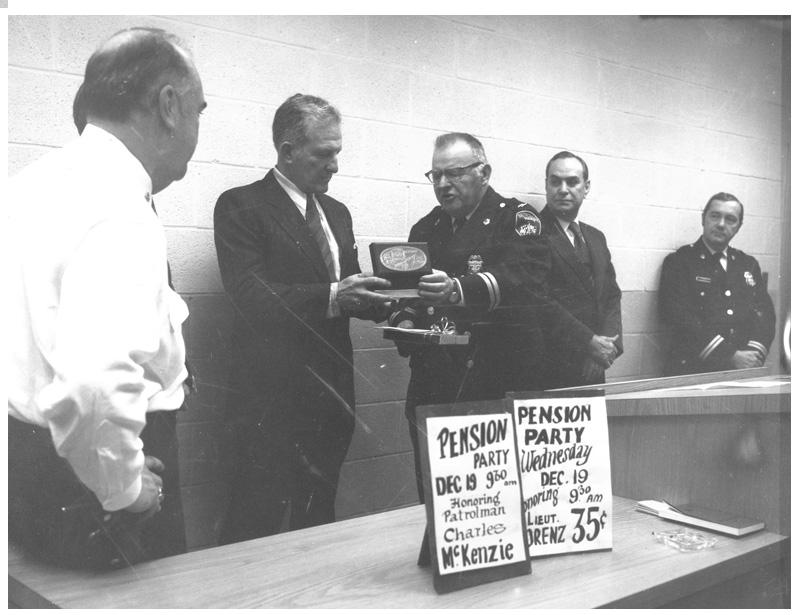
COURTESY MAJOR ROBERT DiSTEFANO
Pension party for Officer McKenzie and Lt. Lorenz.
Captain George Klanders, Deputy Commissioner Battaglia, and Captain John Barnold

COURTESY MAJOR ROBERT DiSTEFANO
![]()
POLICE INFORMATION
Copies of: Your Baltimore Police Department Class Photo, Pictures of our Officers, Vehicles, Equipment, Newspaper Articles relating to our department and or officers, Old Departmental Newsletters, Lookouts, Wanted Posters, and or Brochures. Information on Deceased Officers and anything that may help Preserve the History and Proud Traditions of this agency. Please contact Retired Detective Kenny Driscoll.

NOTICE
How to Dispose of Old Police Items
Please contact Det. Ret. Kenny Driscoll if you have any pictures of you or your family members and wish them remembered here on this tribute site to Honor the fine men and women who have served with Honor and Distinction at the Baltimore Police Department. Anyone with information, photographs, memorabilia, or other "Baltimore City Police" items can contact Ret. Det. Kenny Driscoll at
Copyright © 2002 Baltimore City Police History - Ret Det Kenny Driscoll
